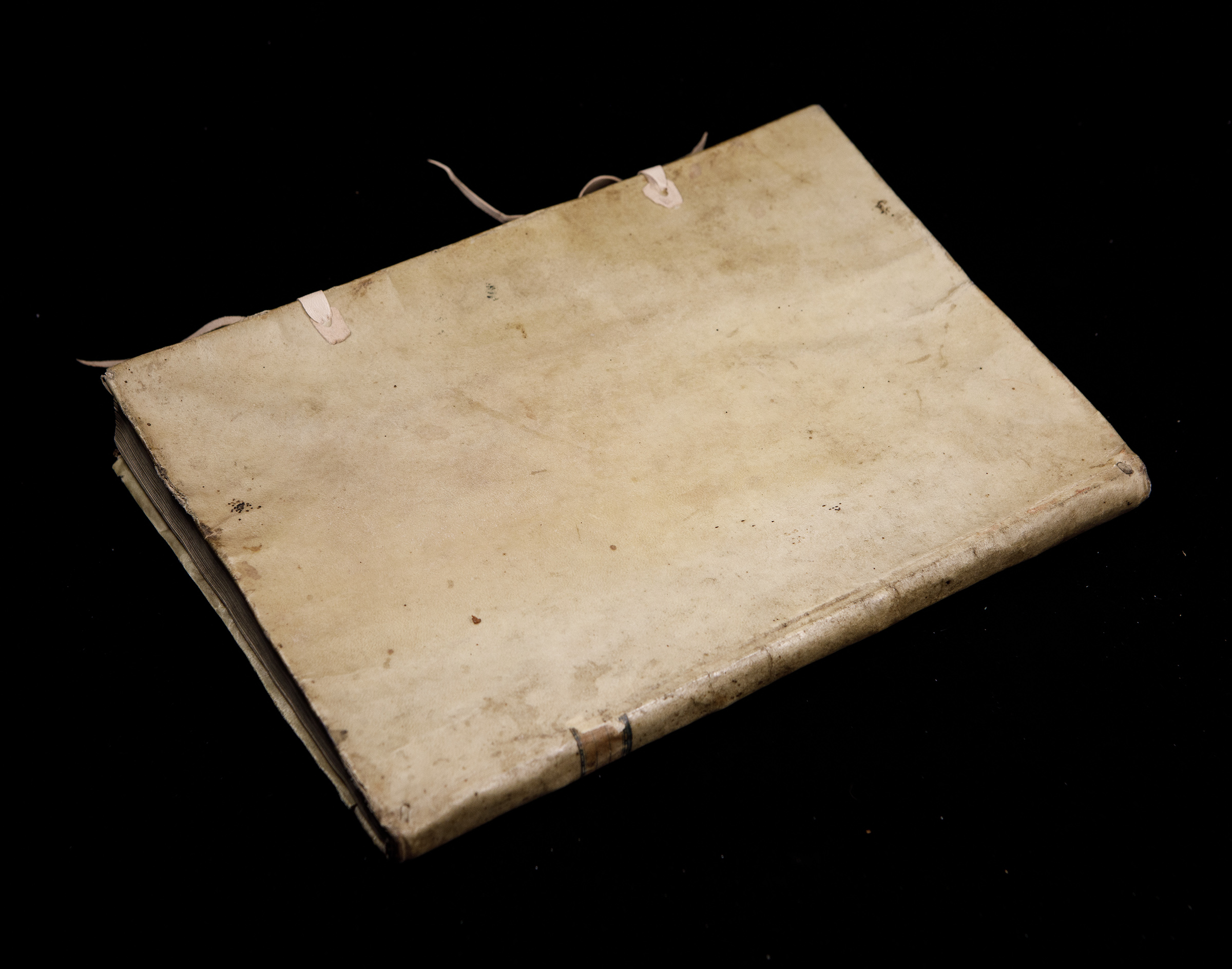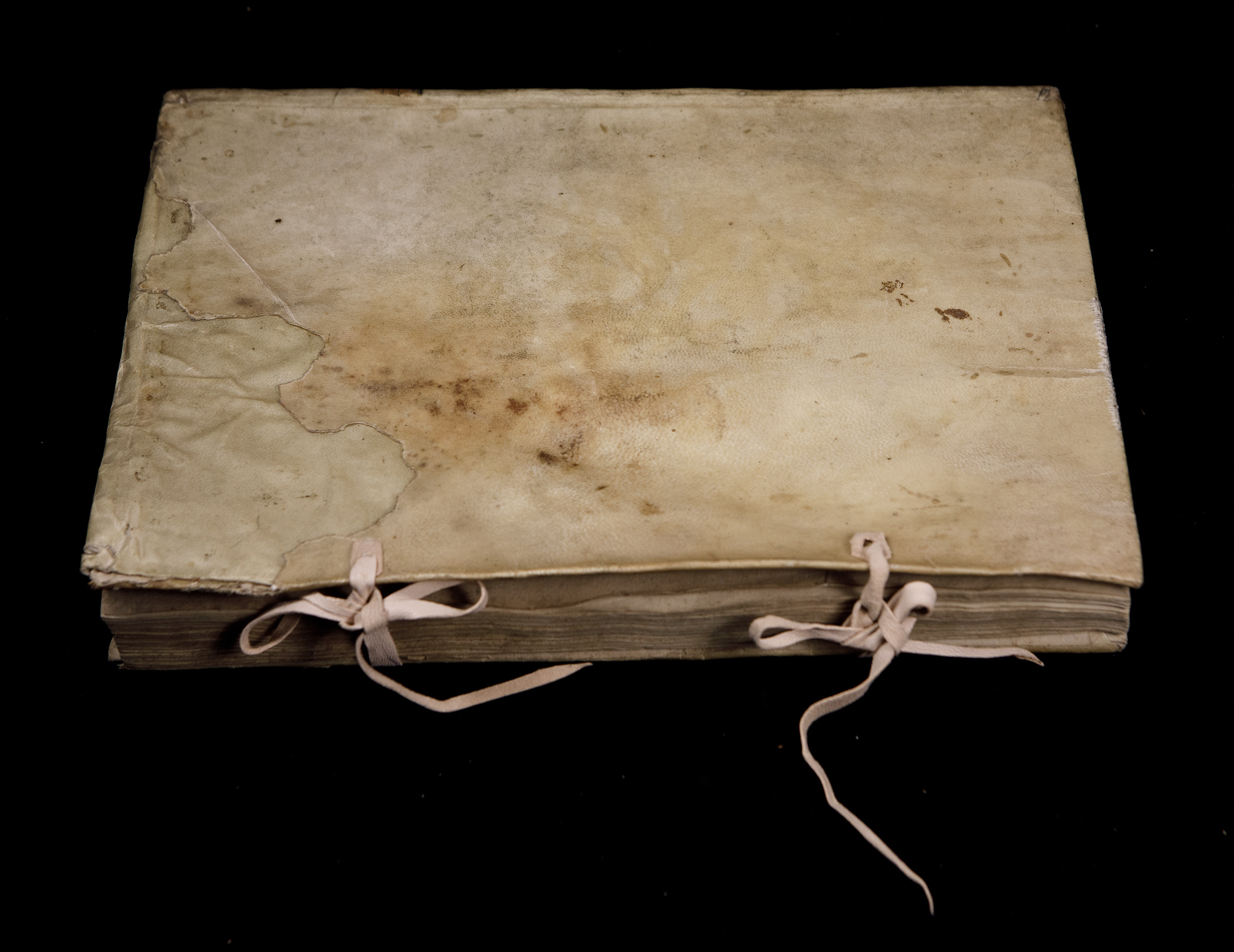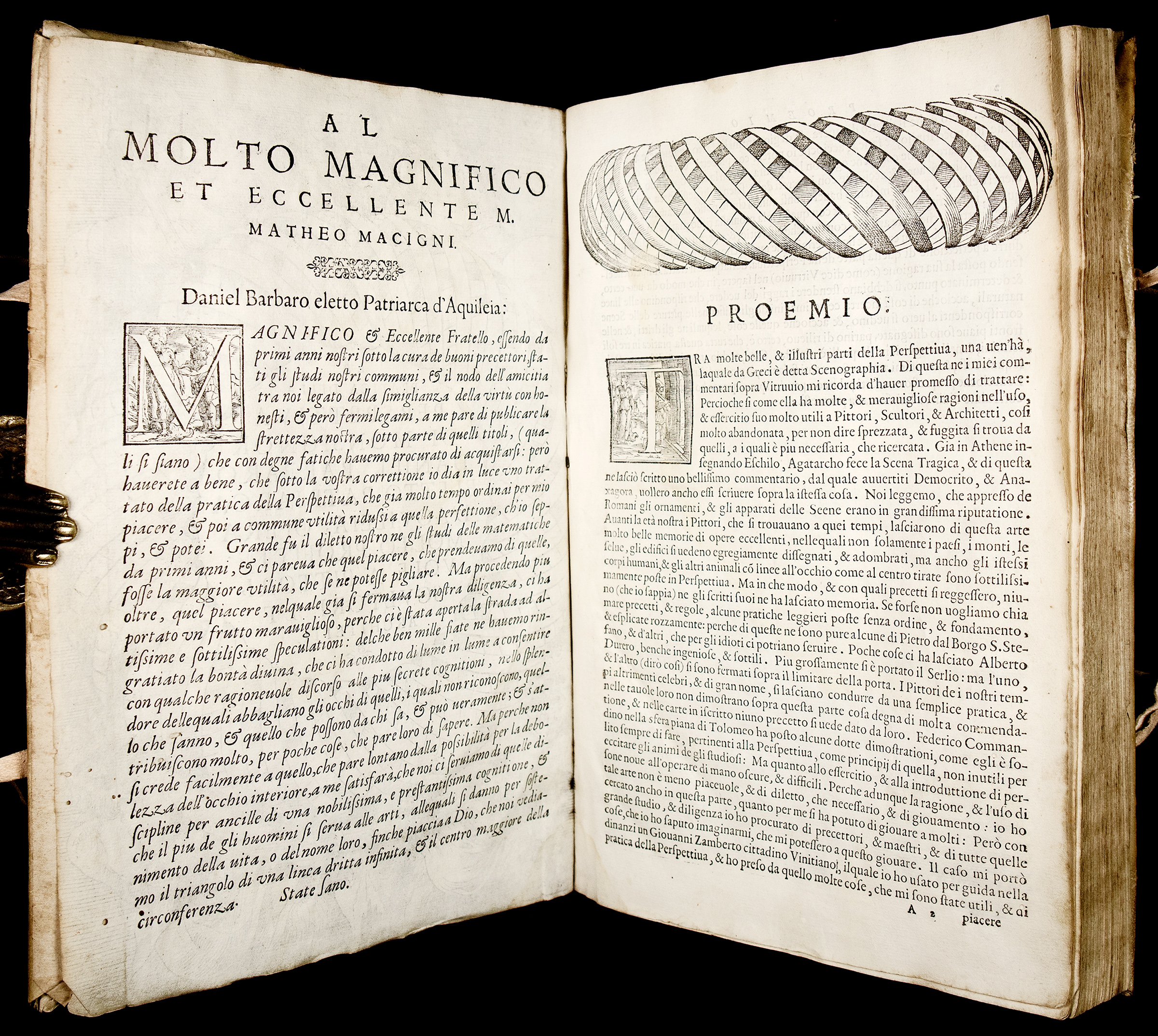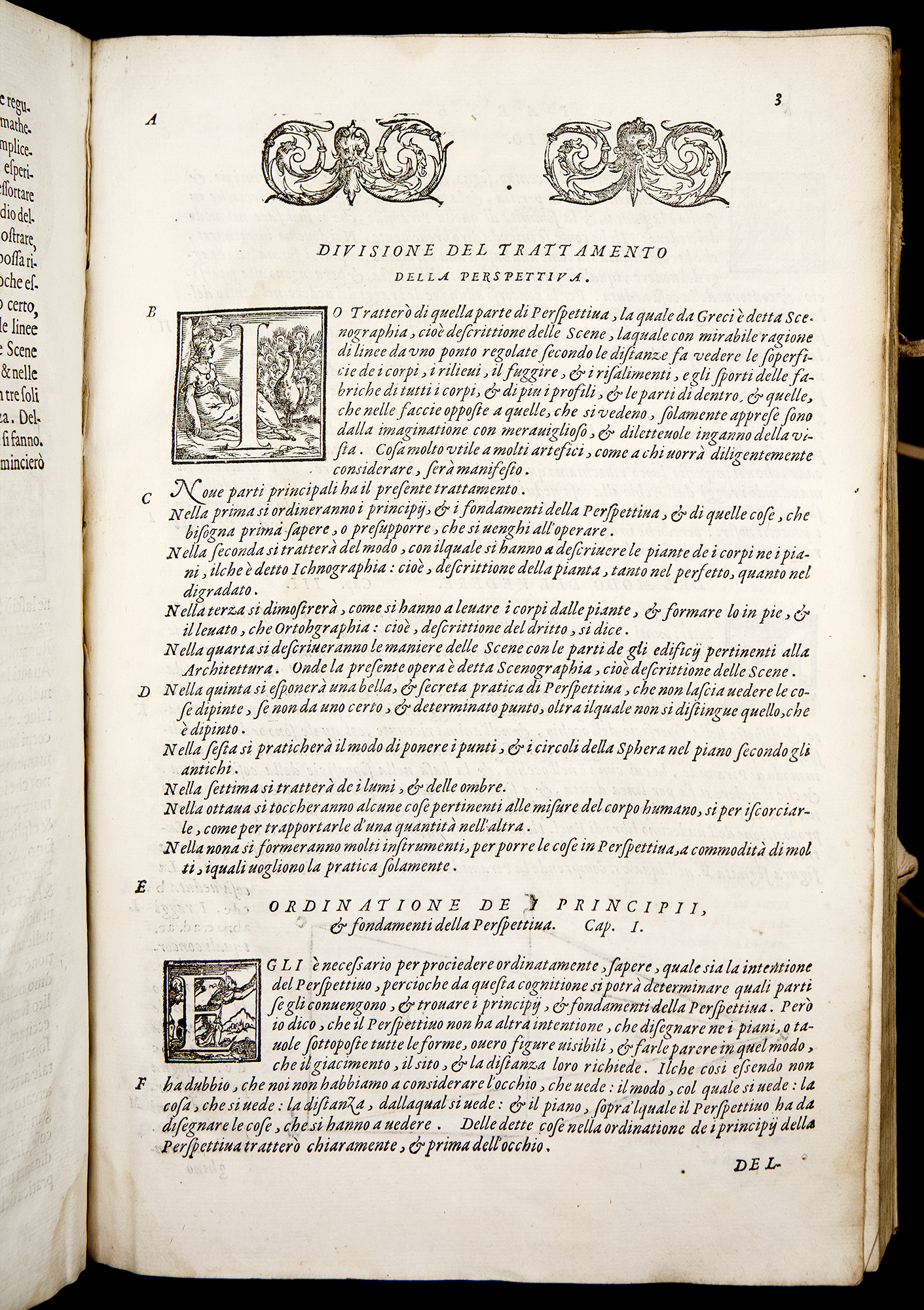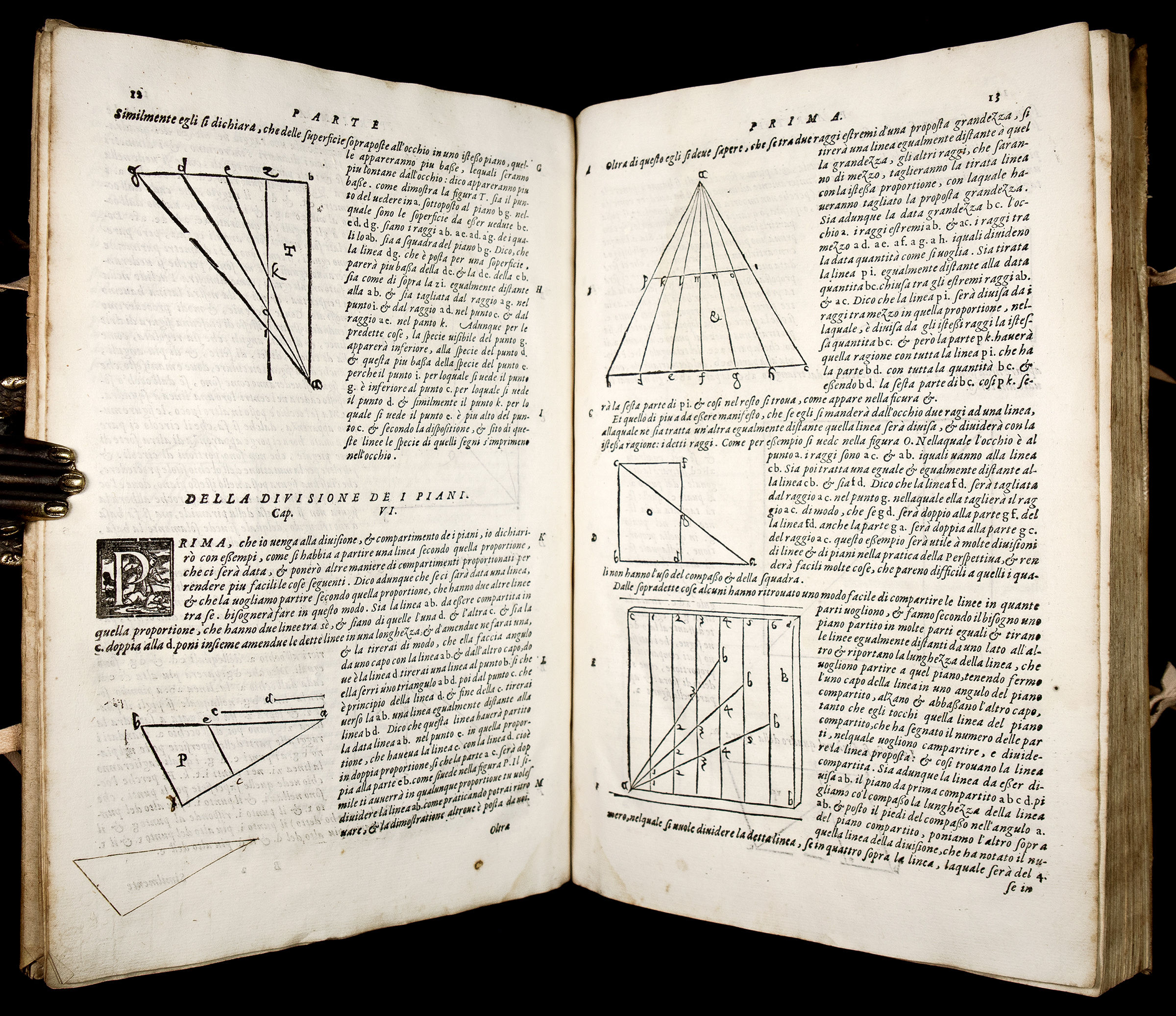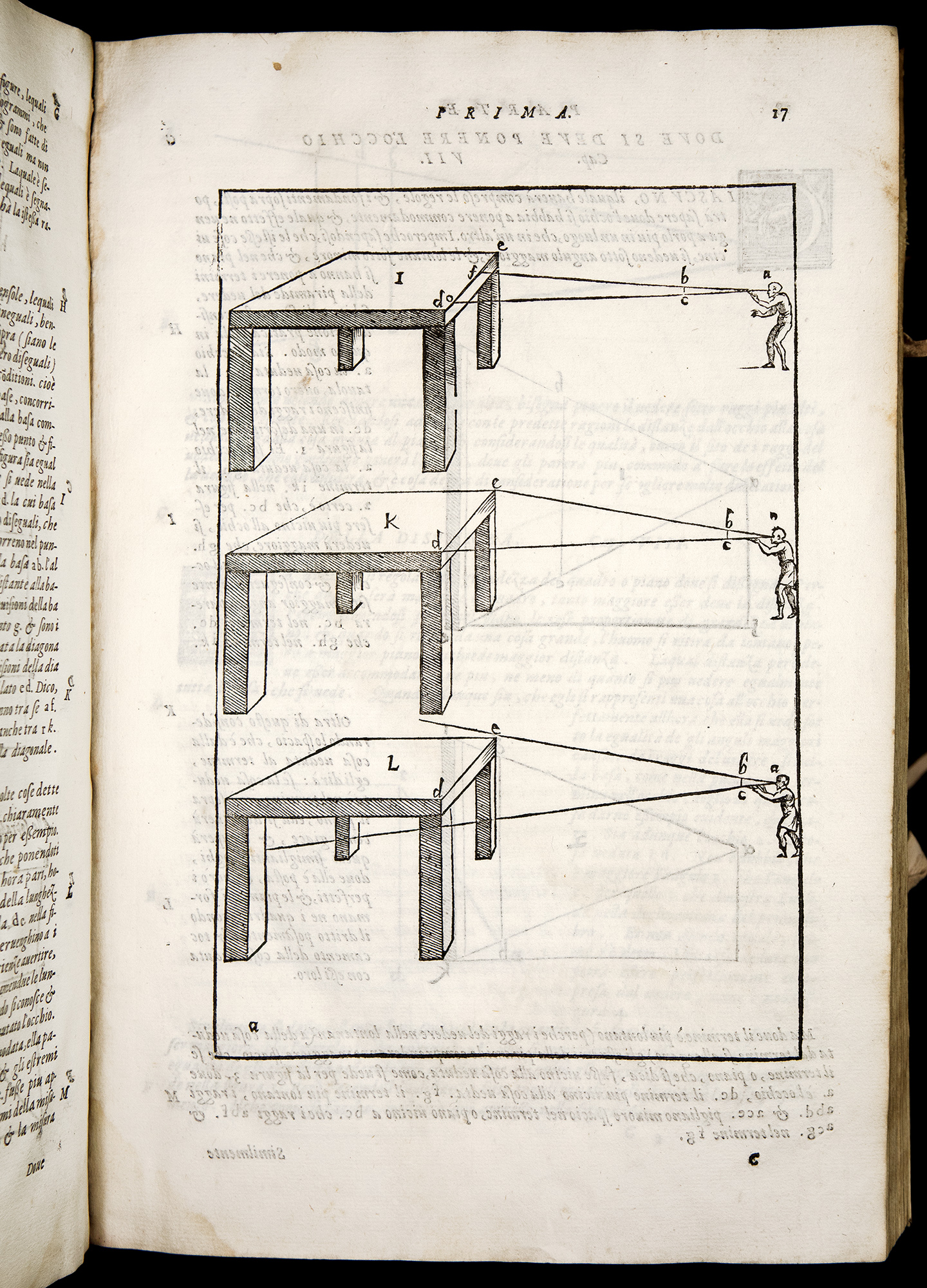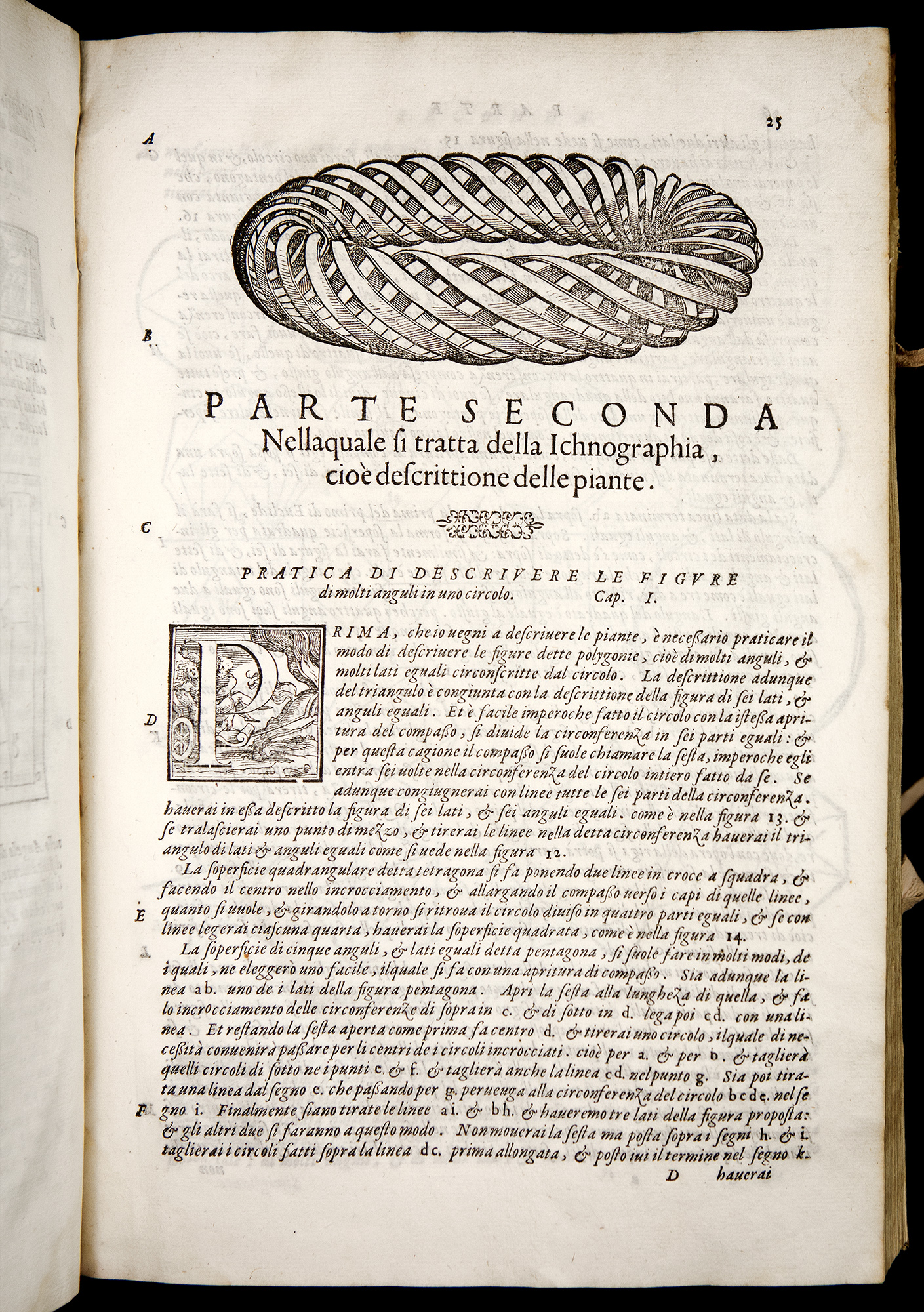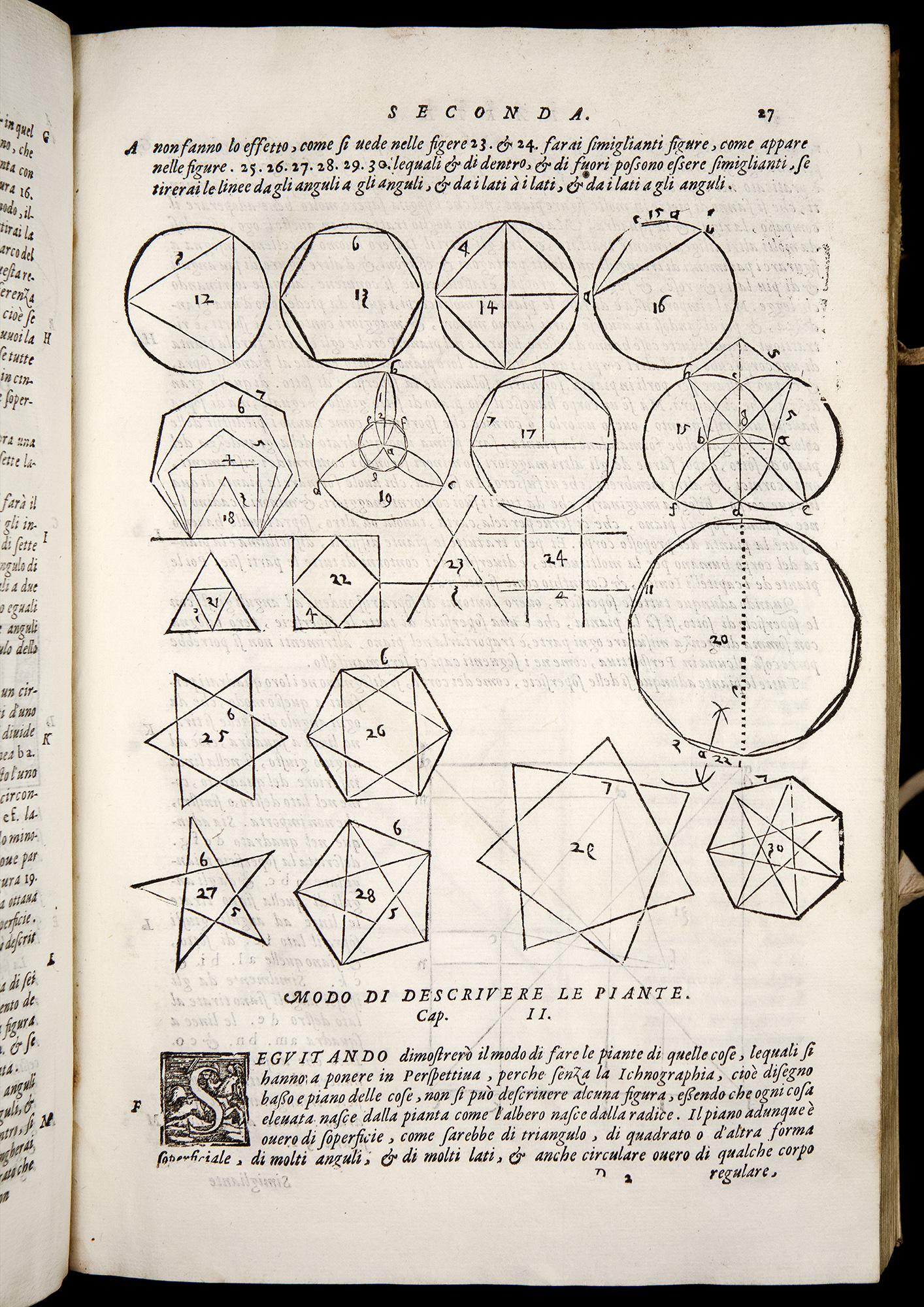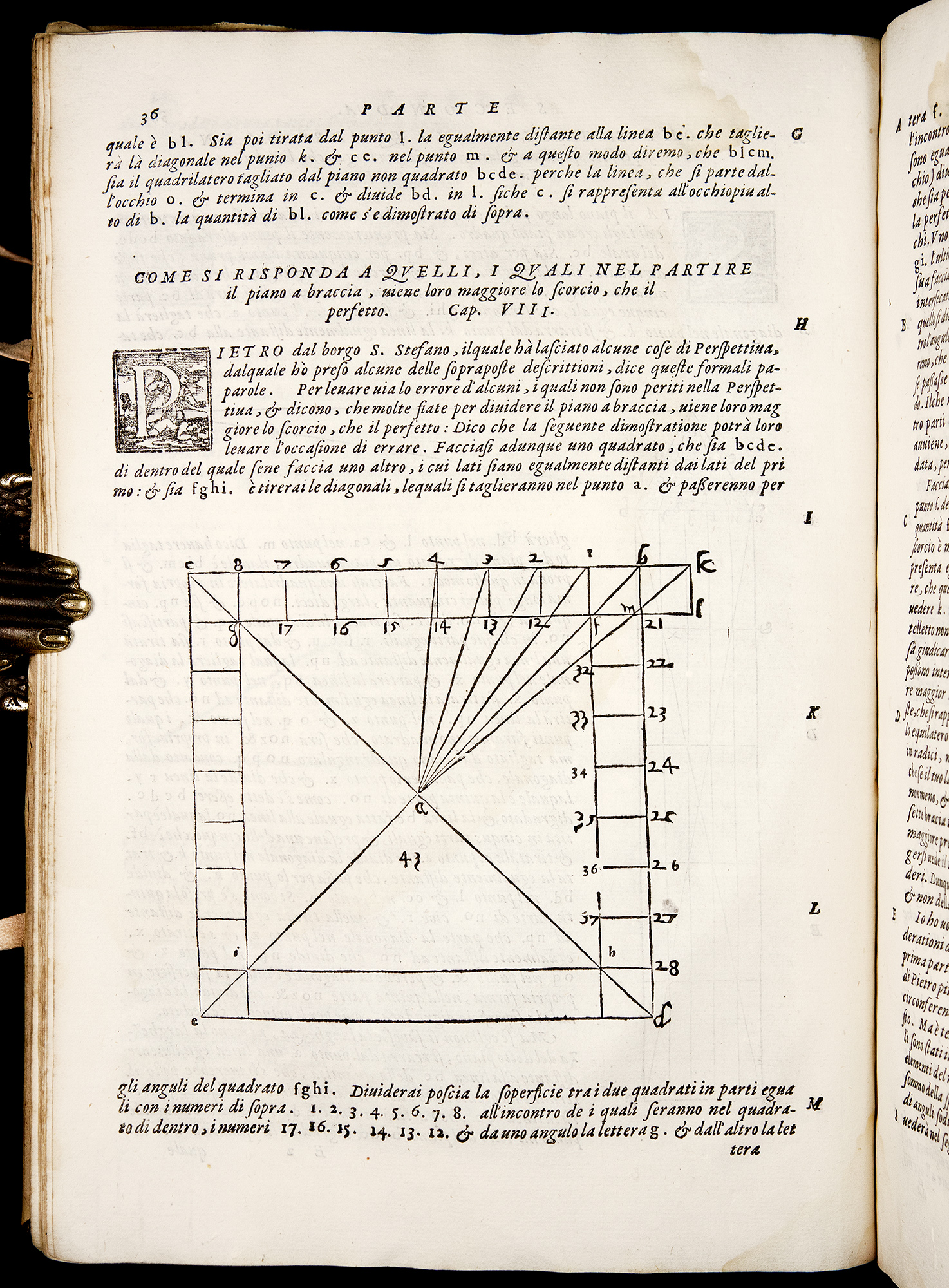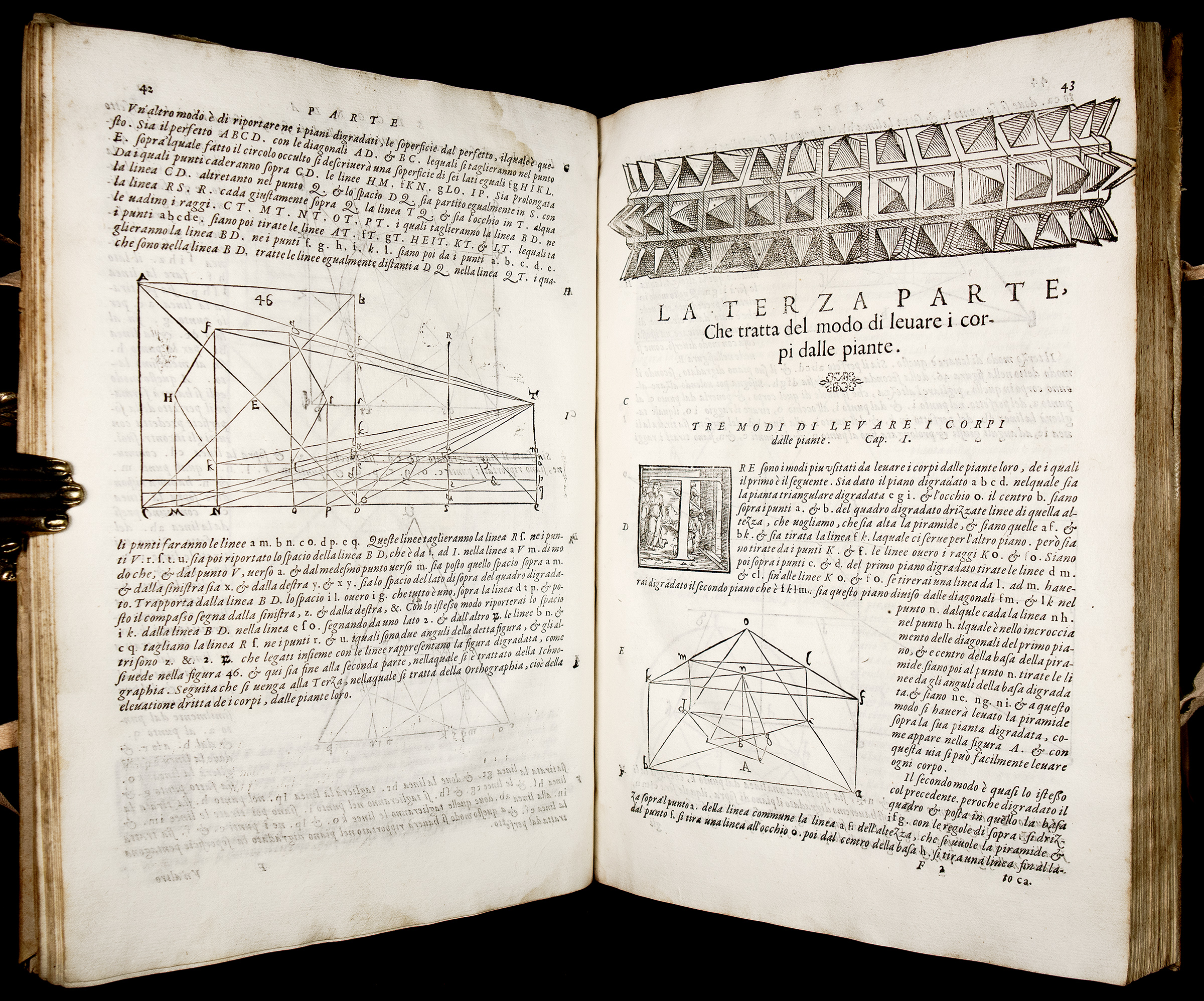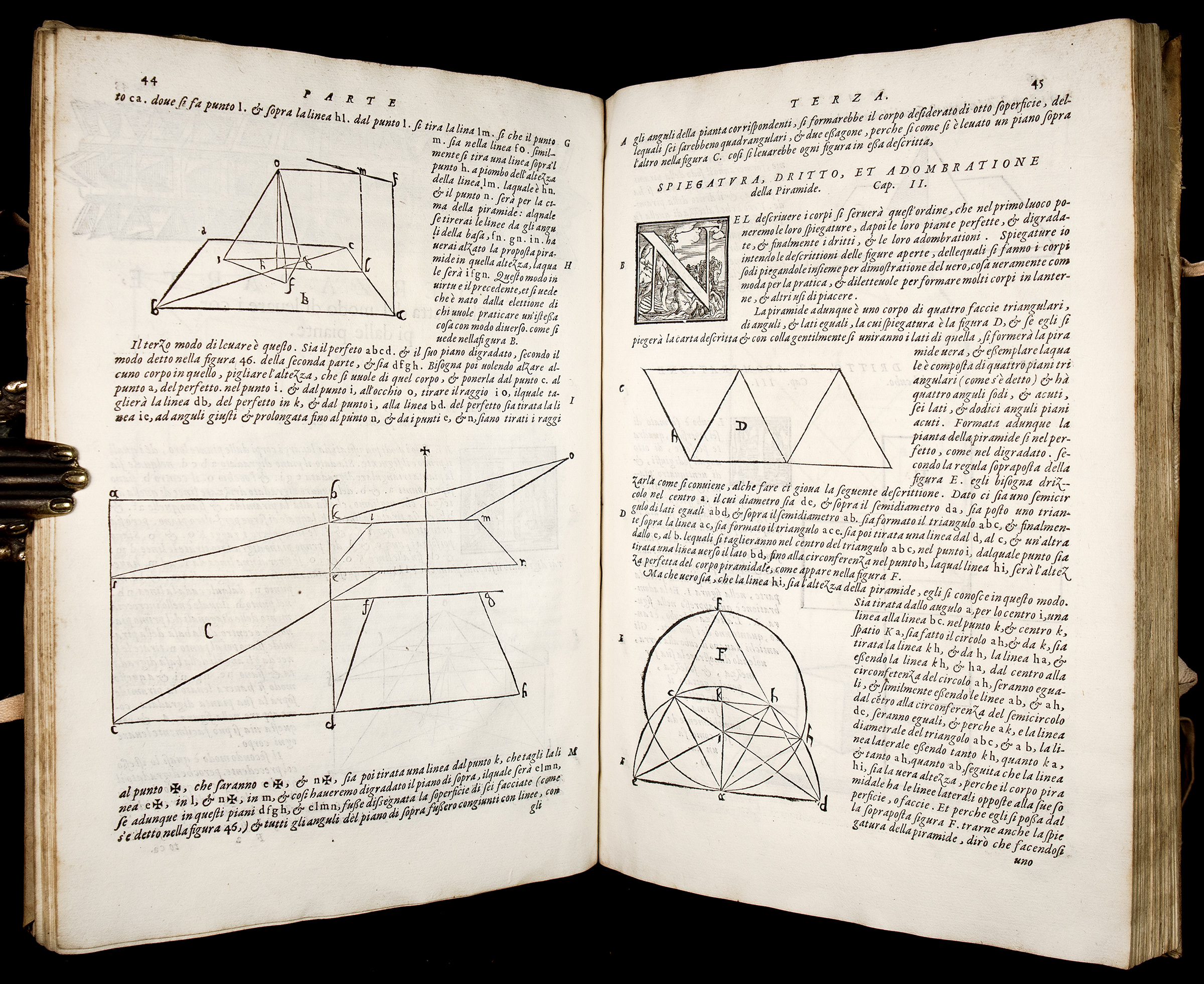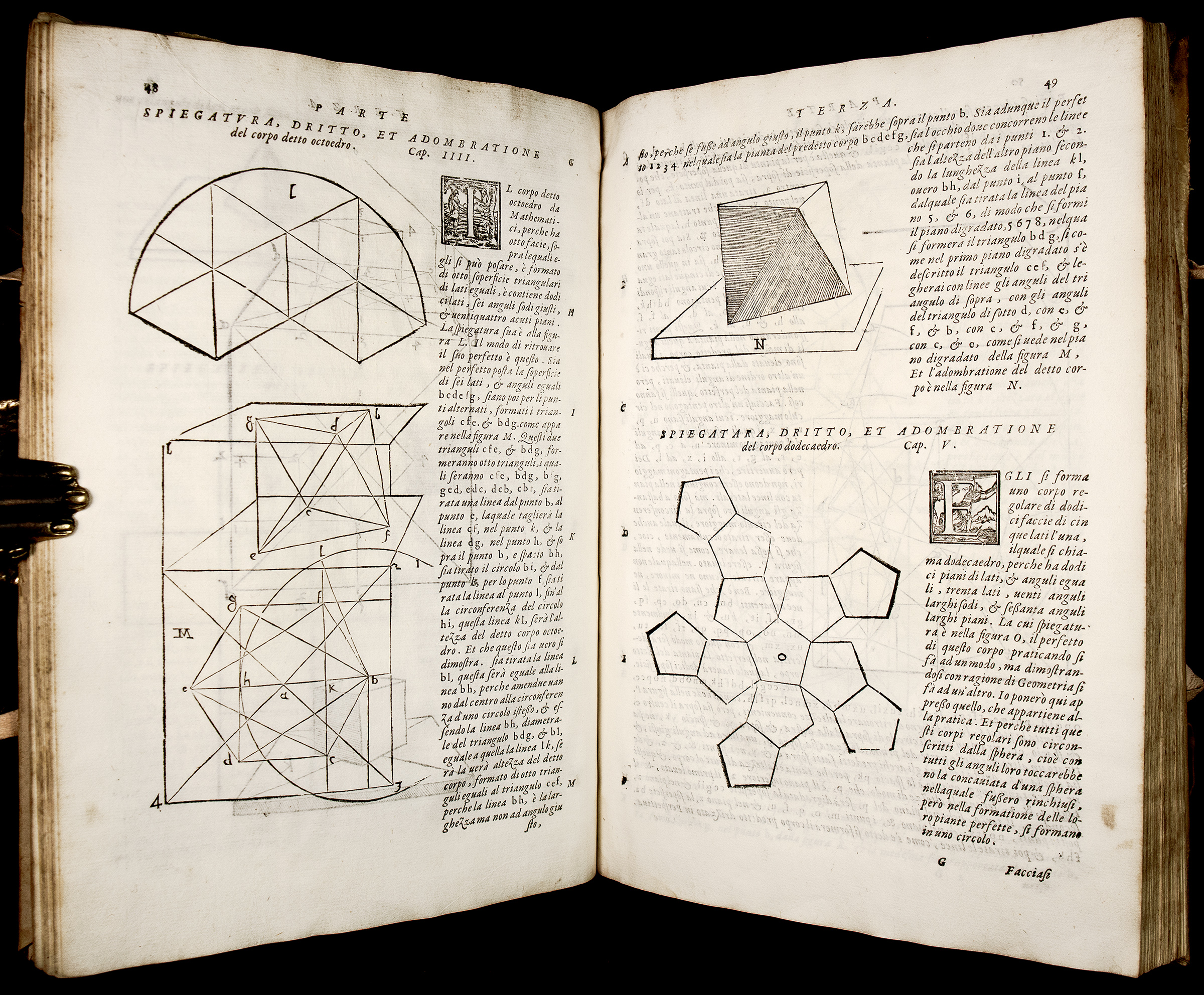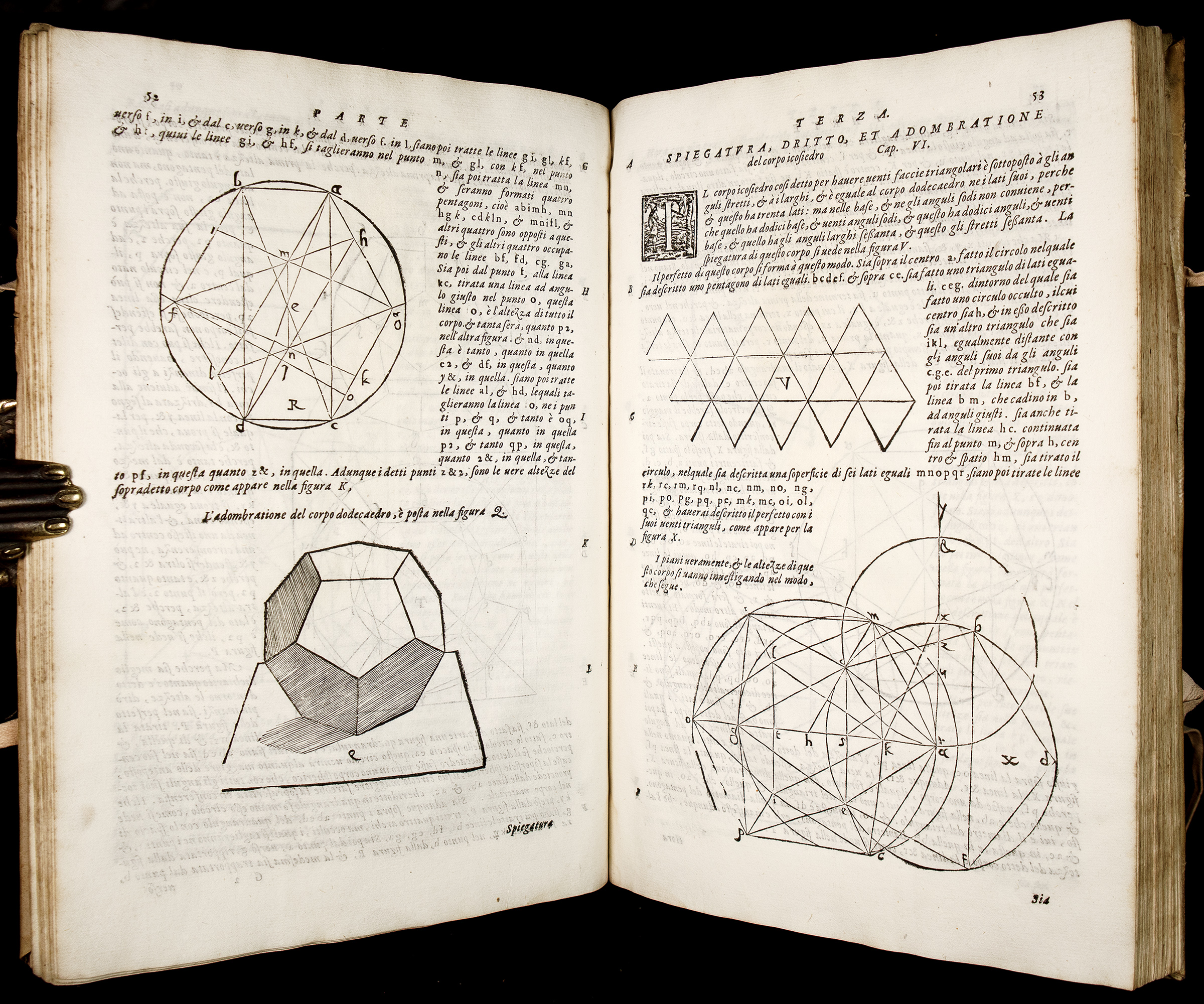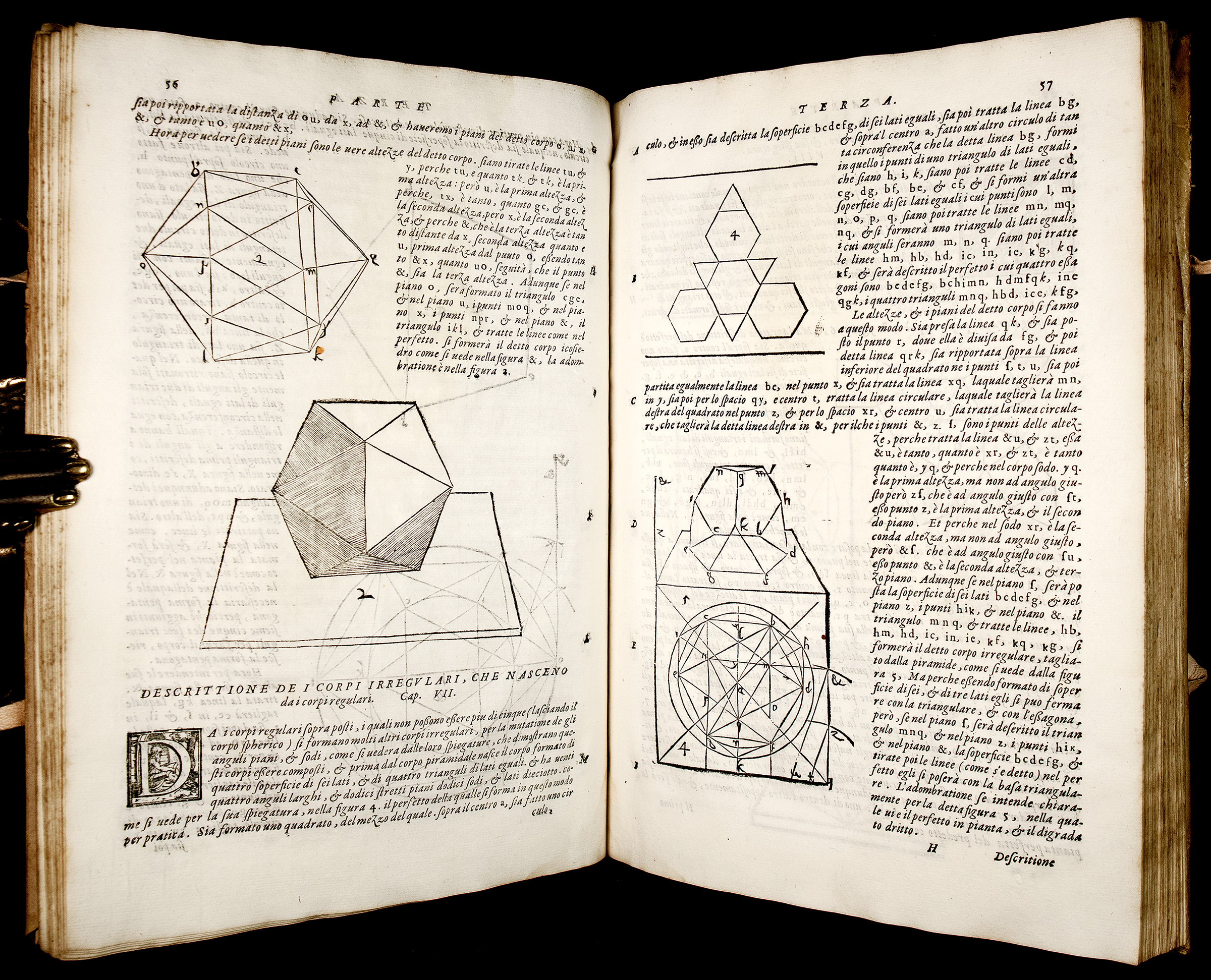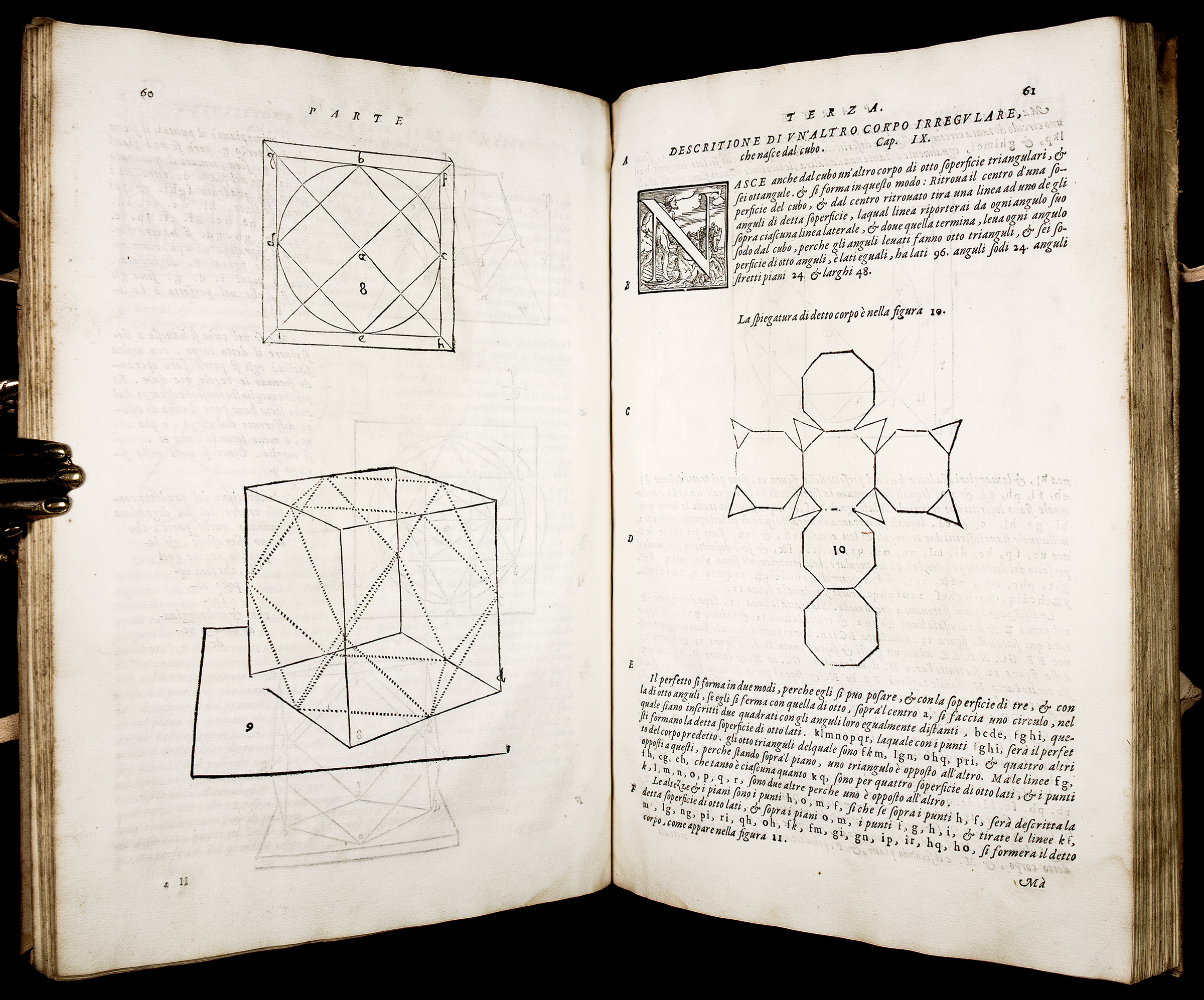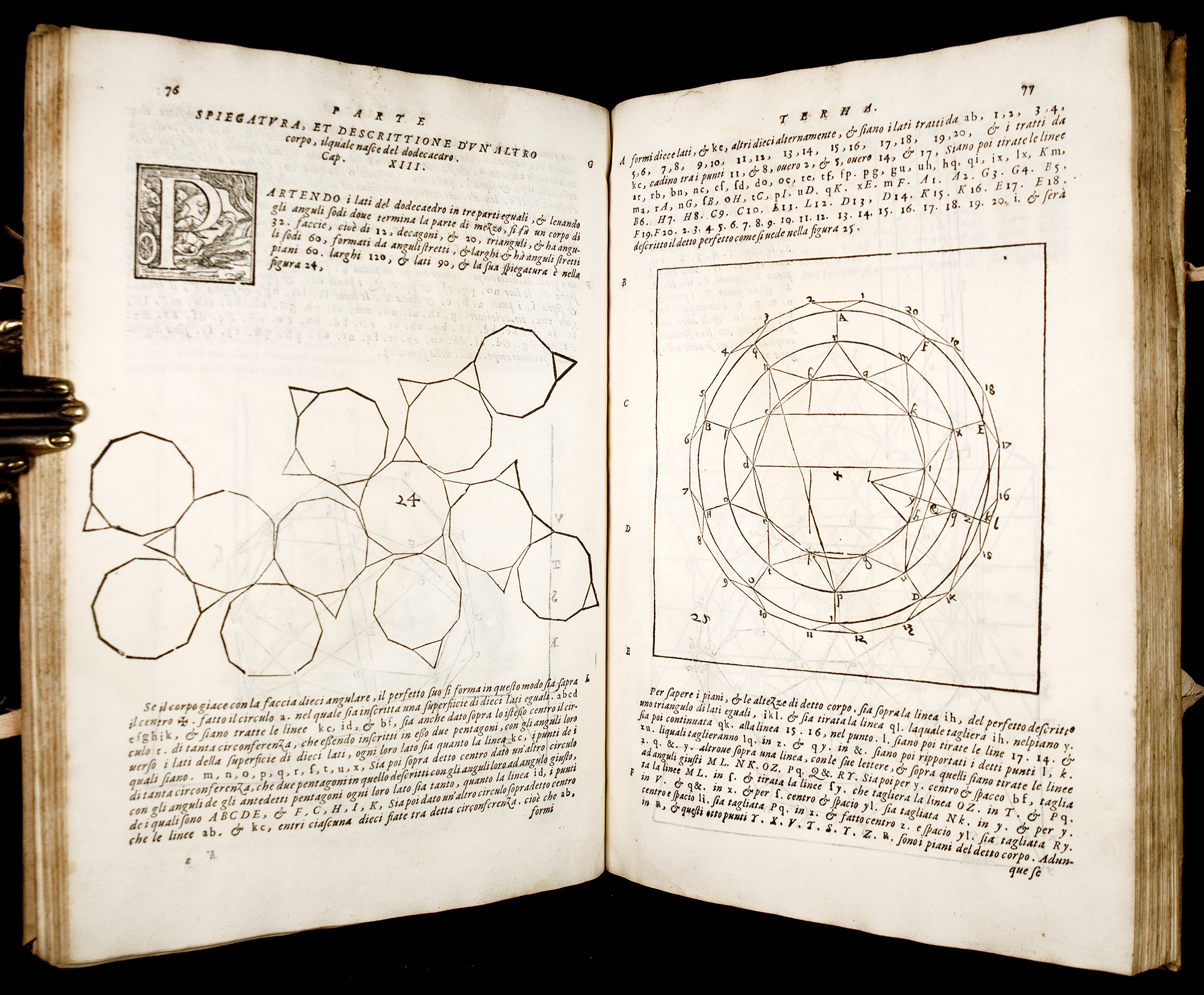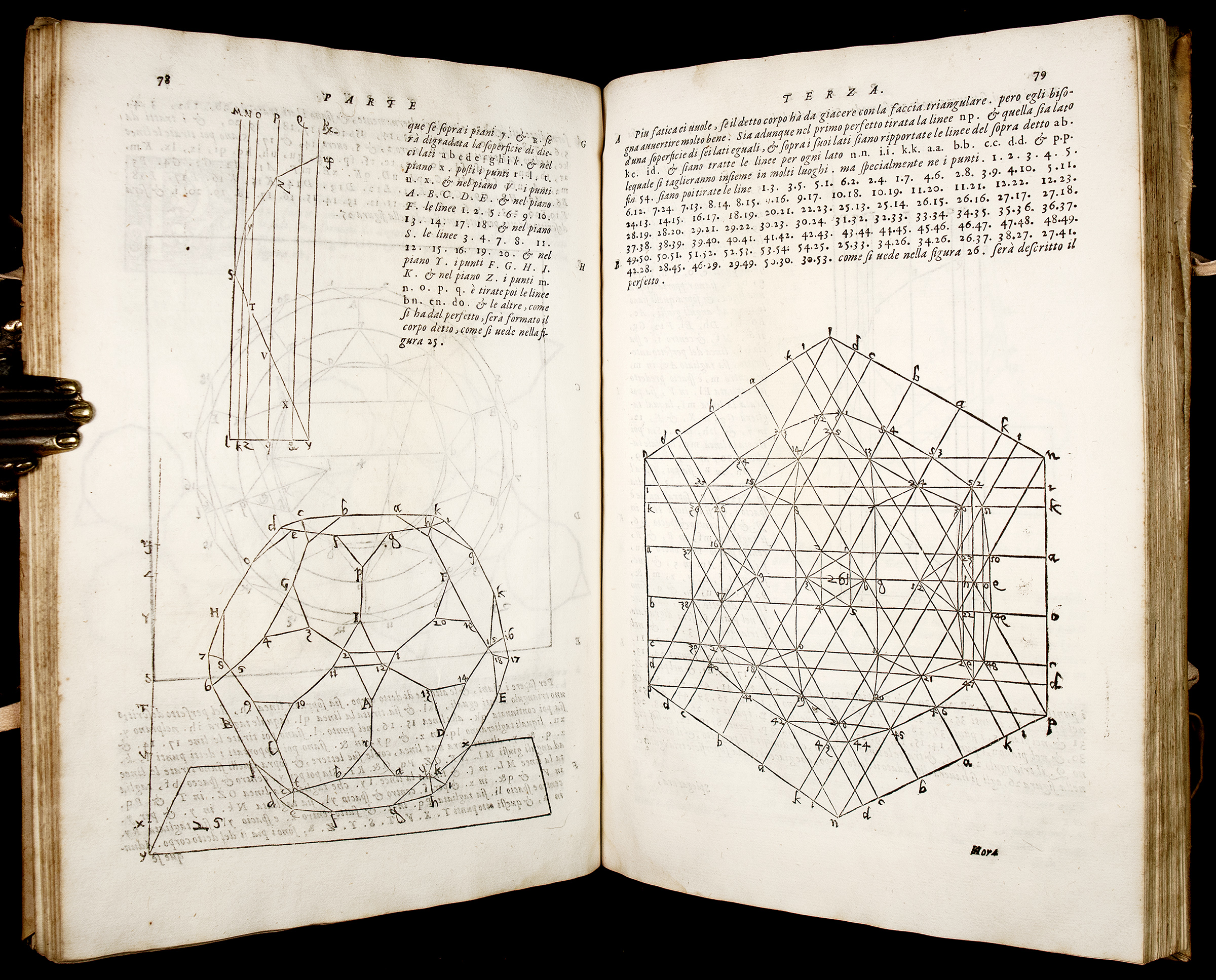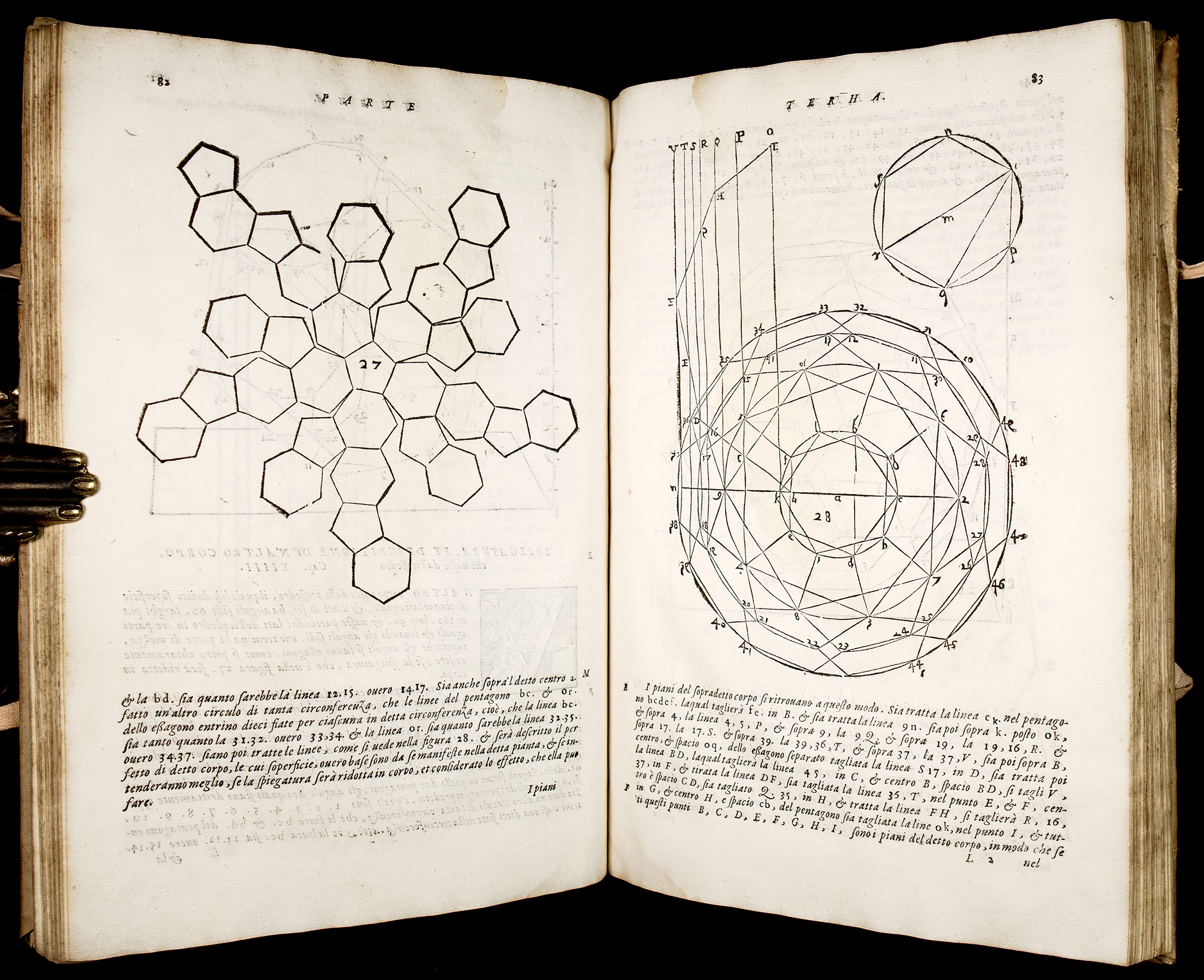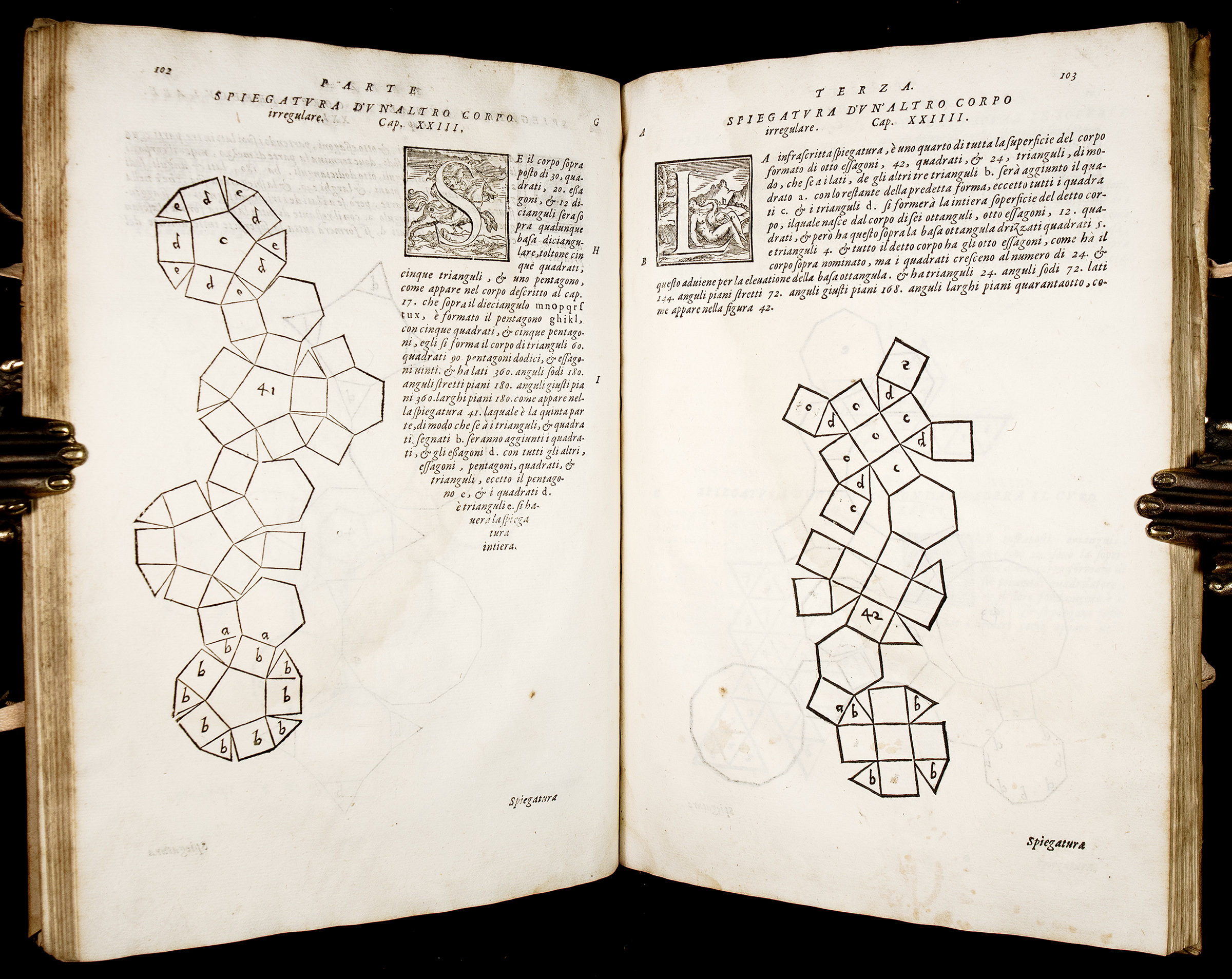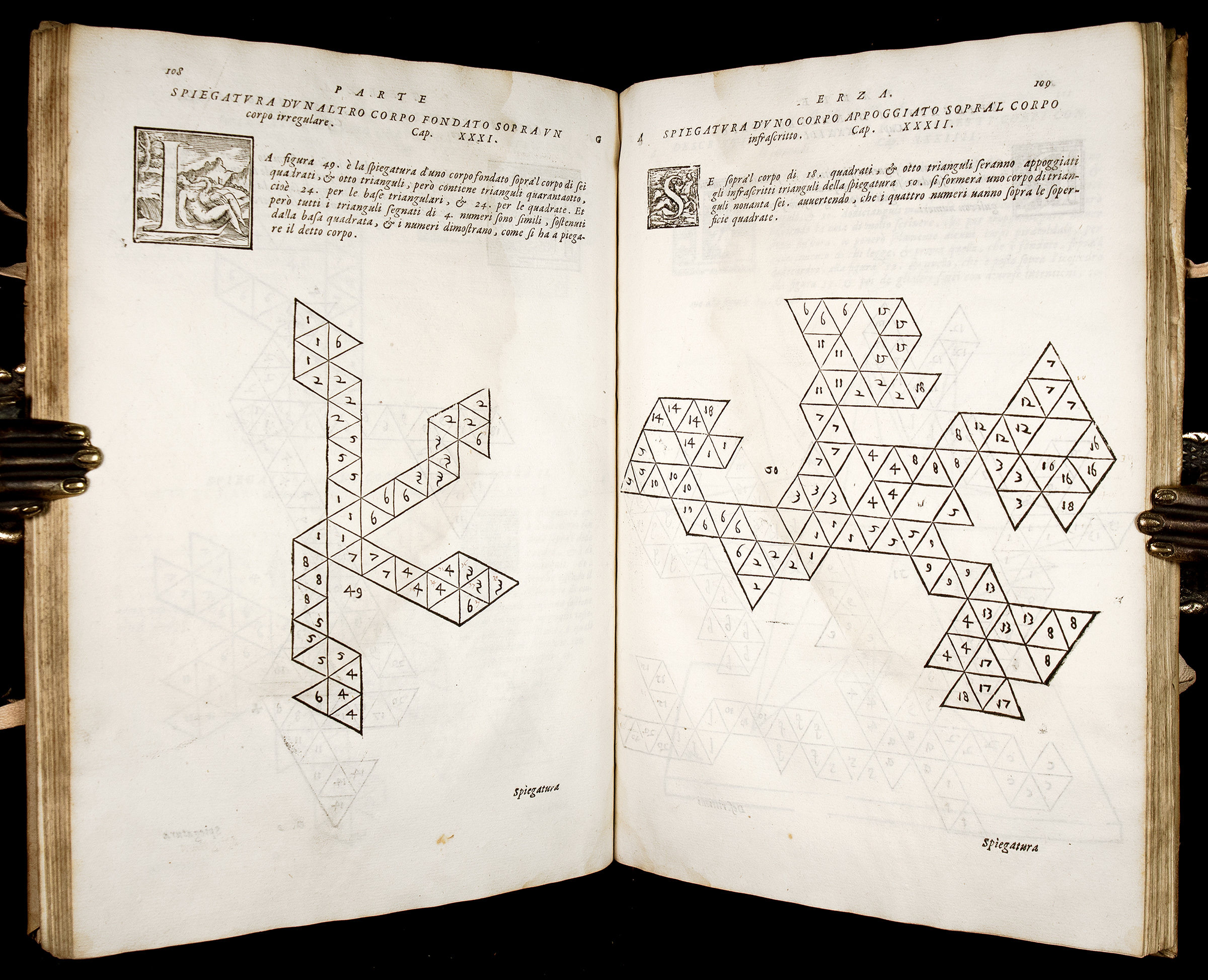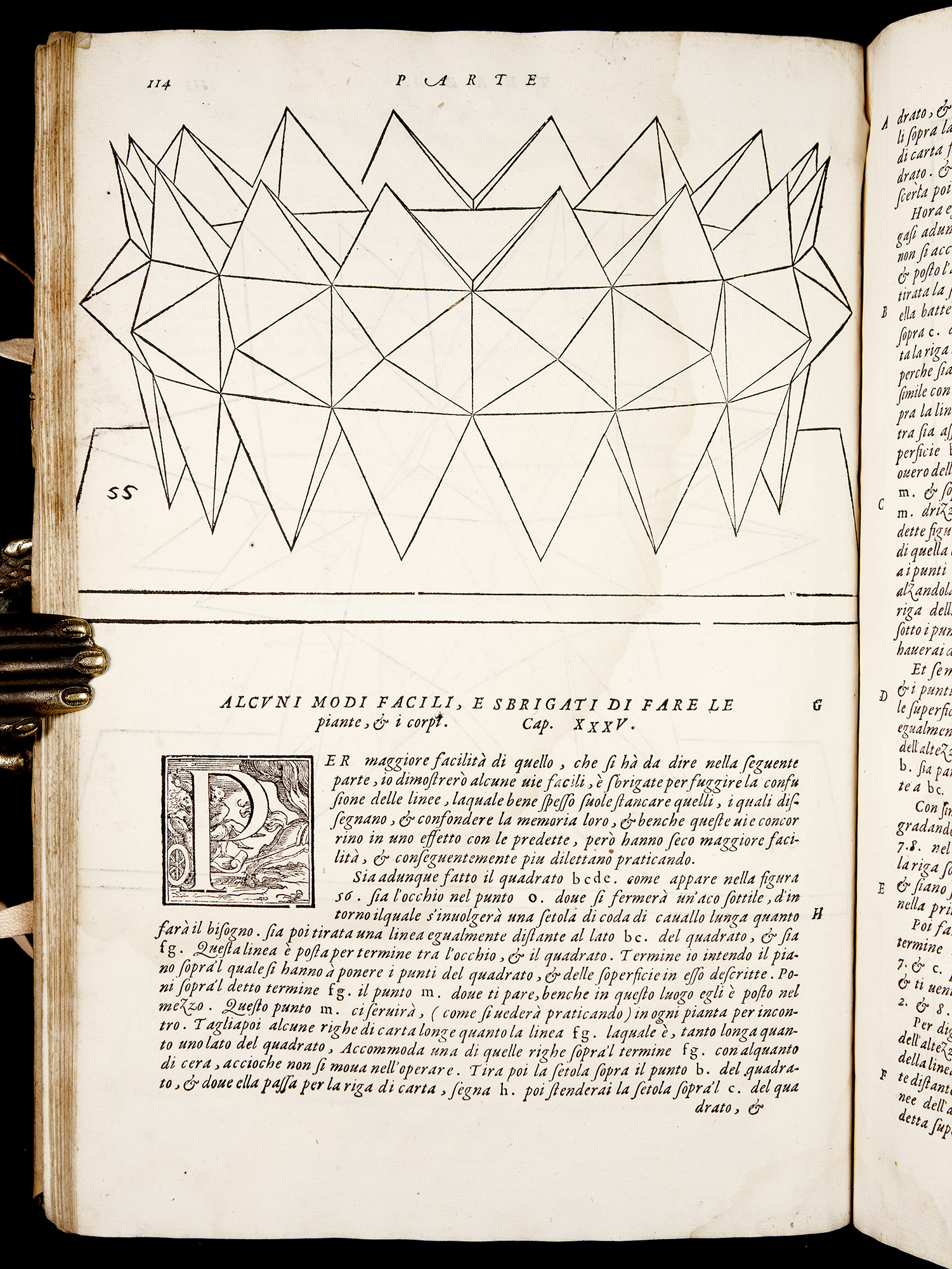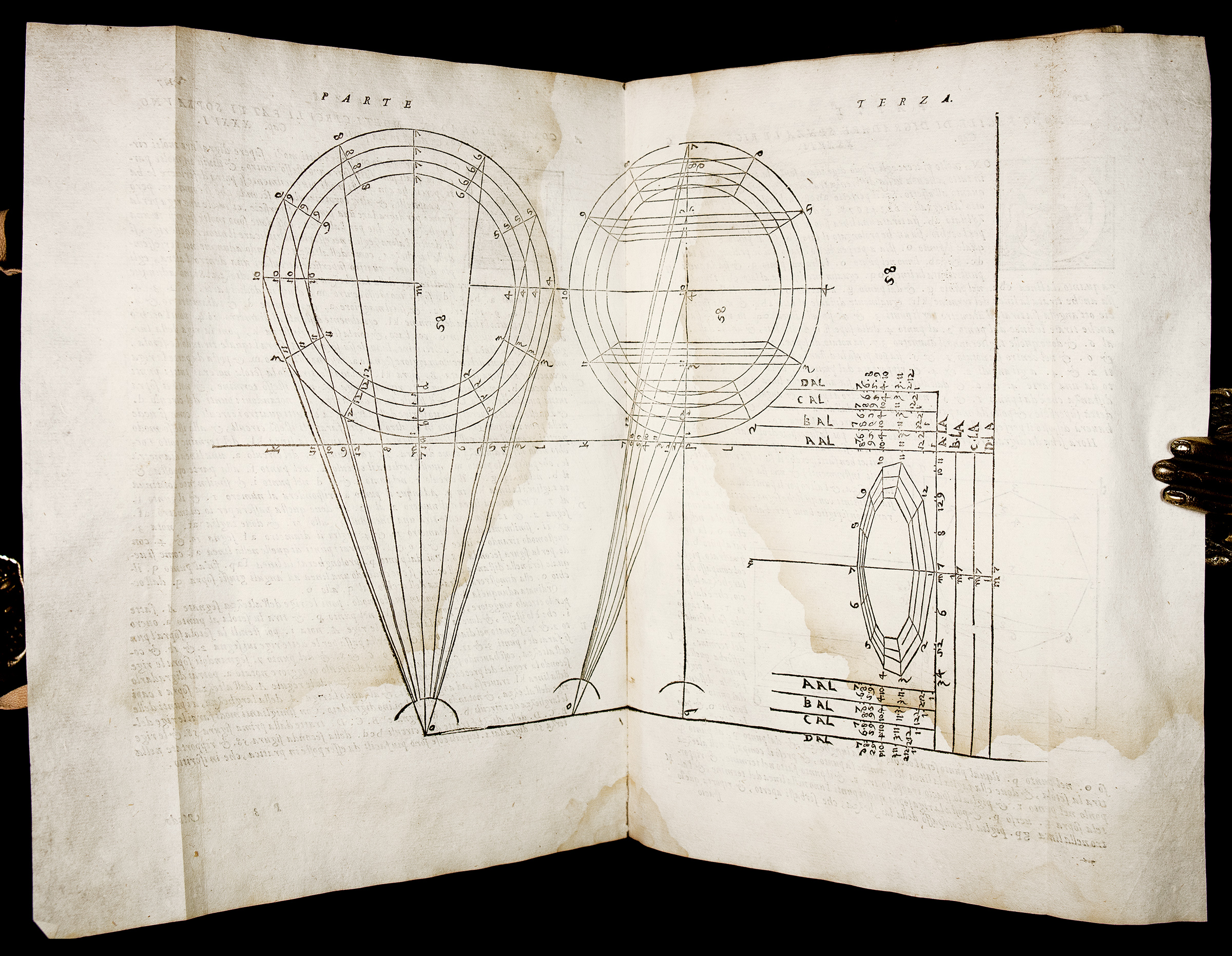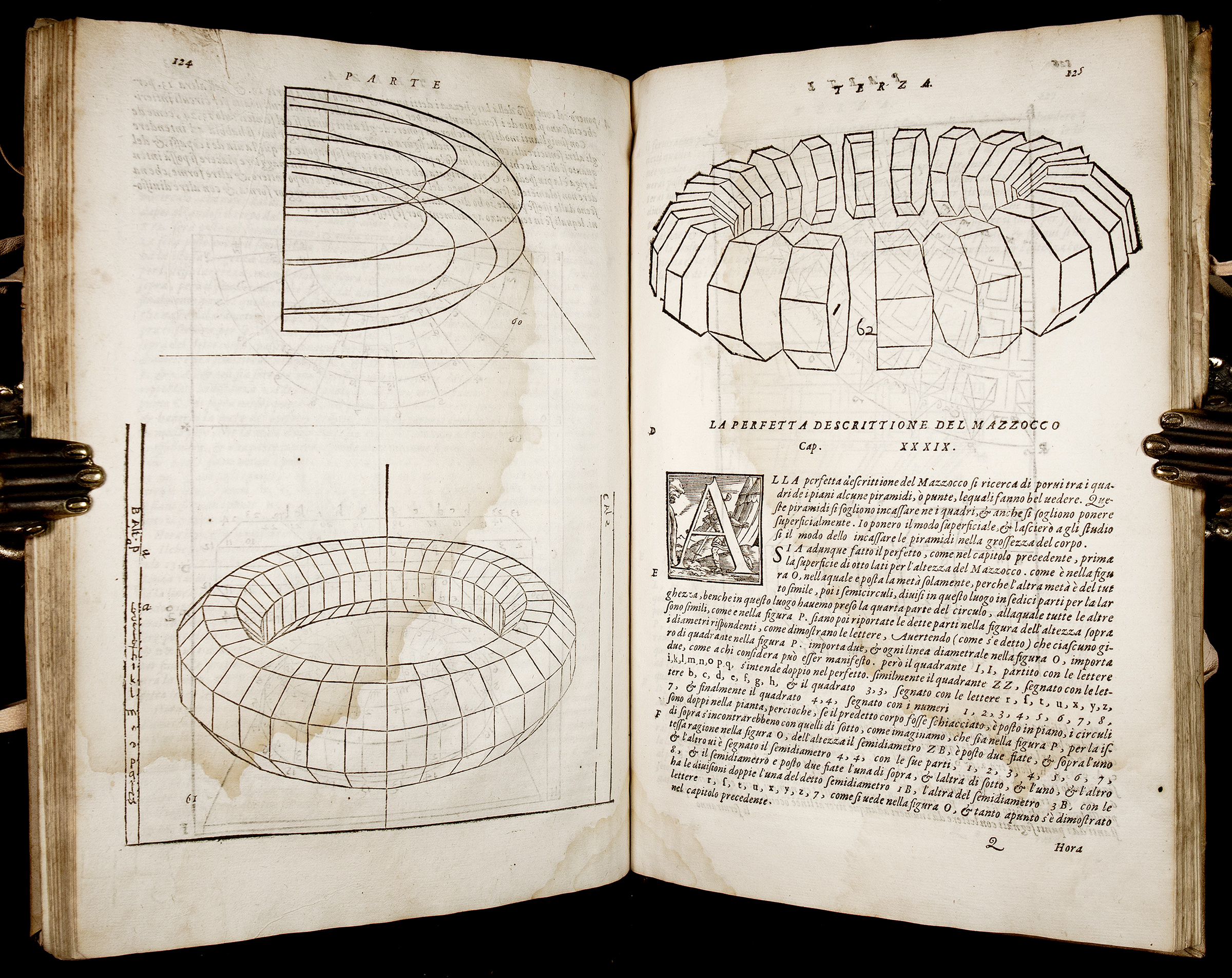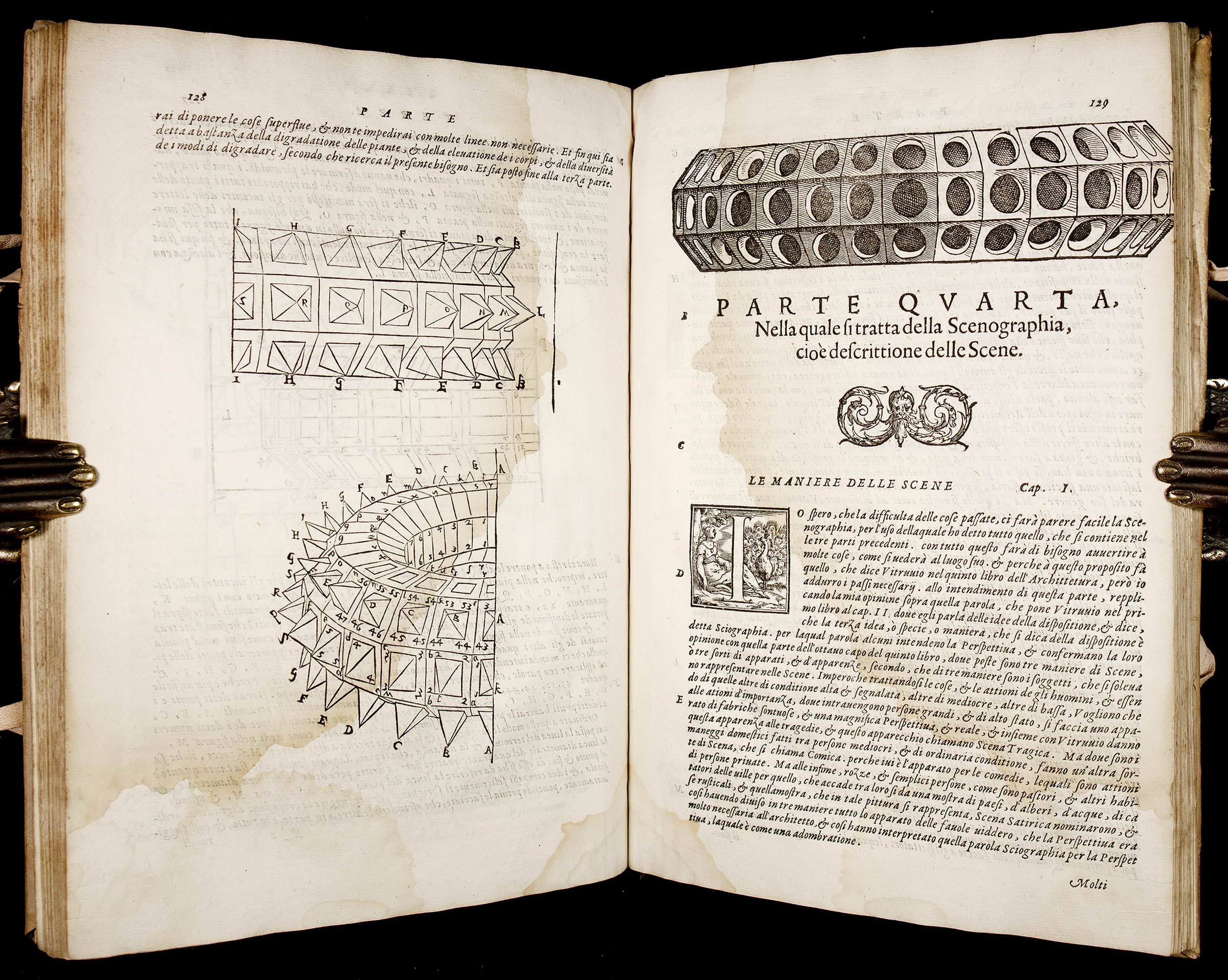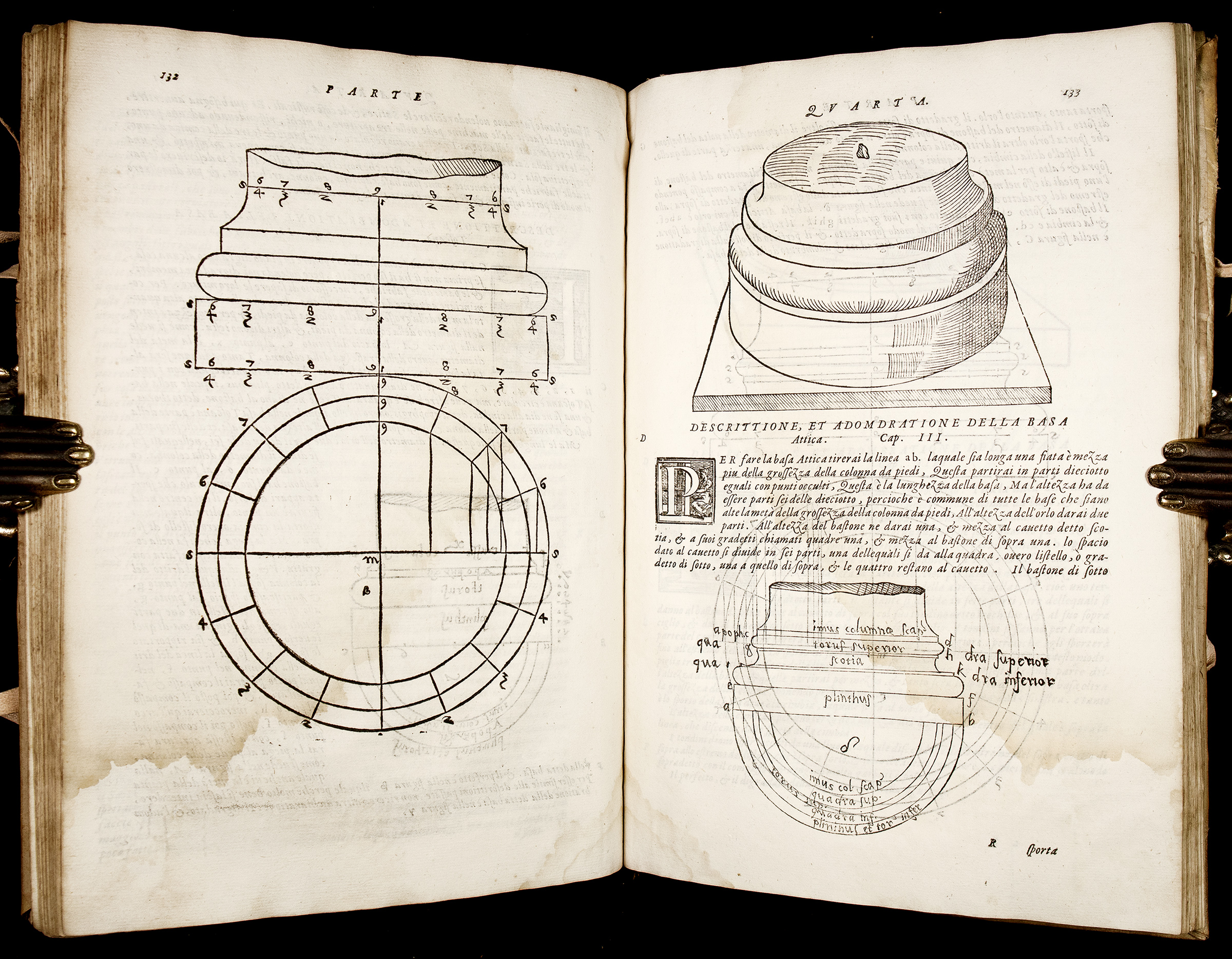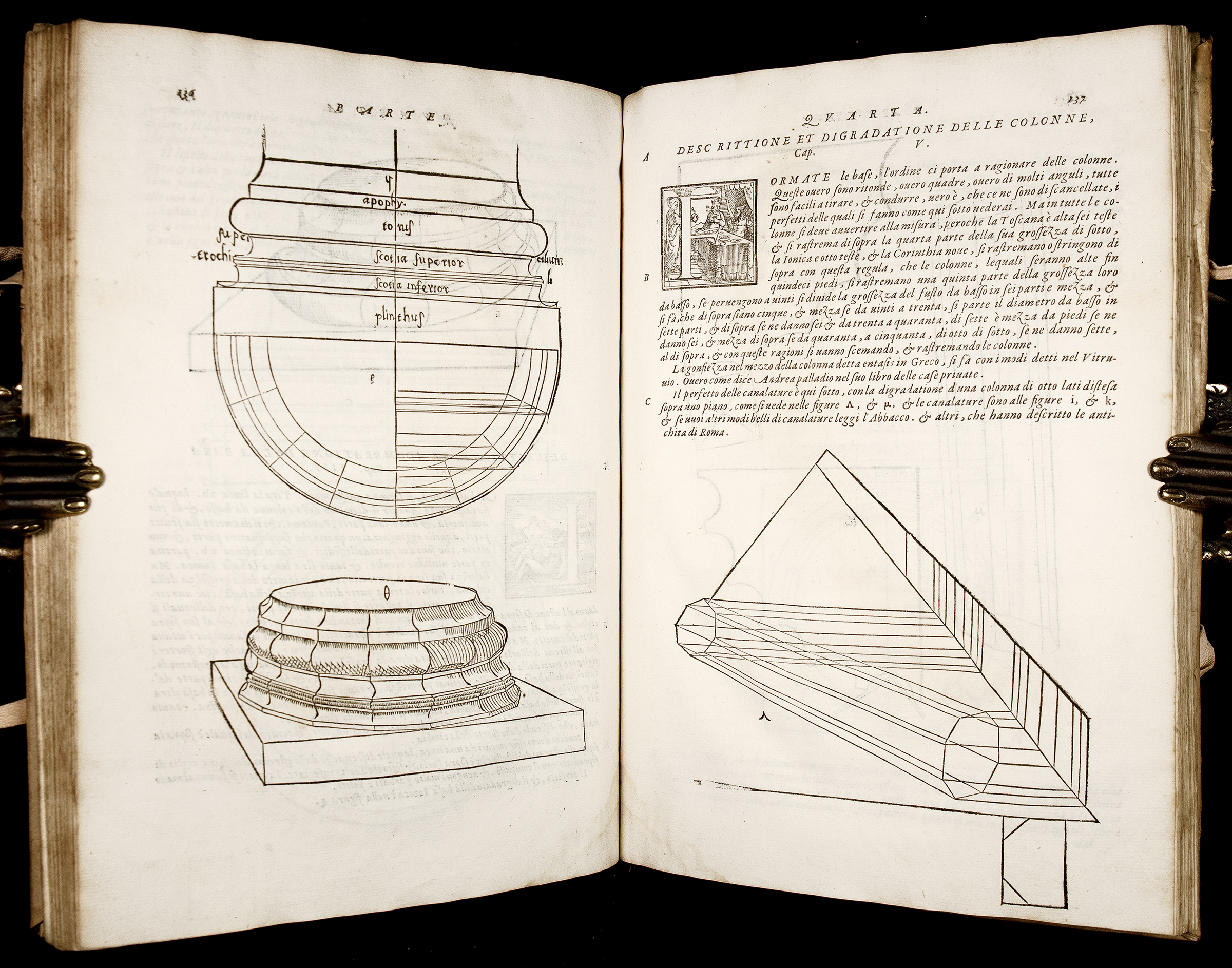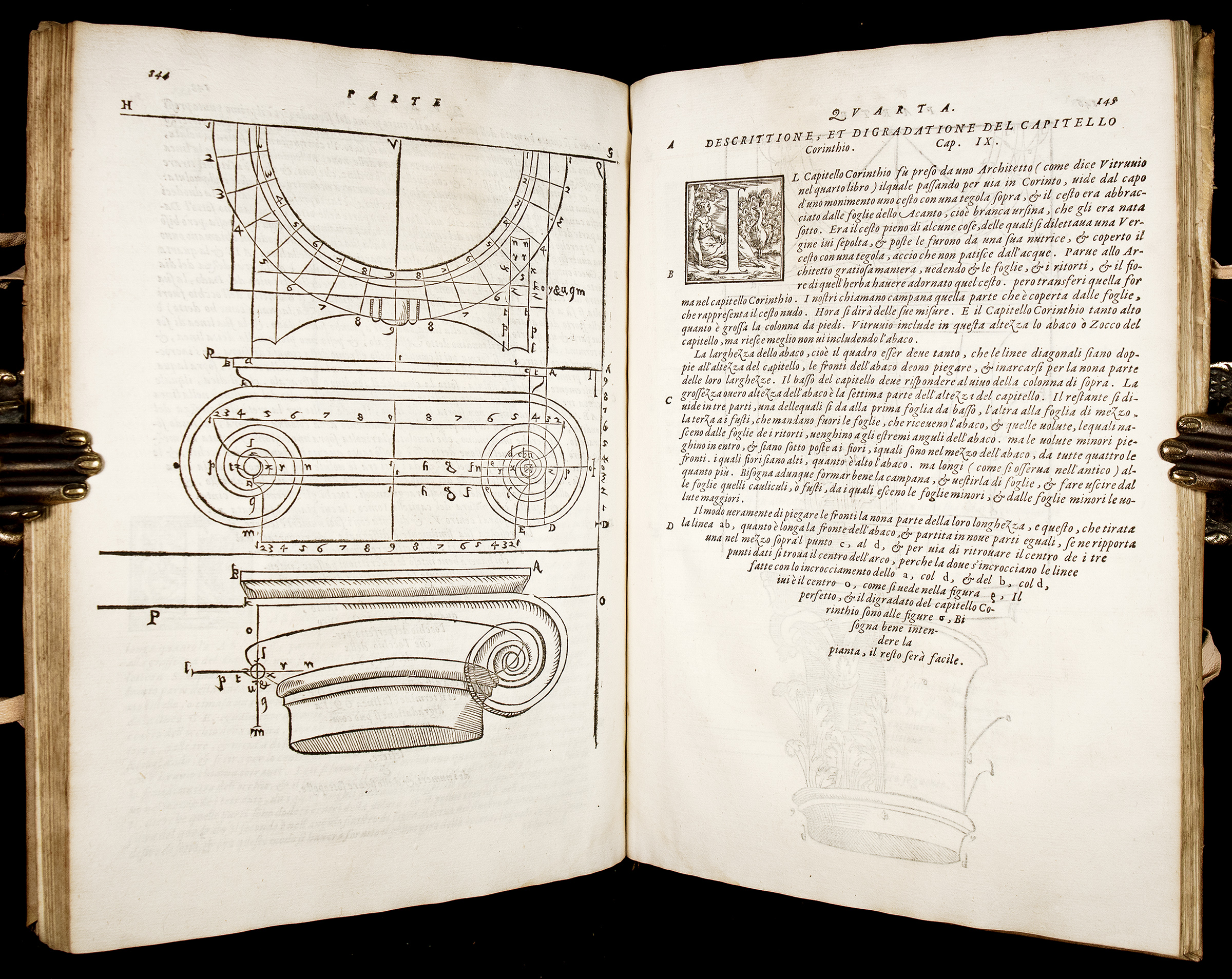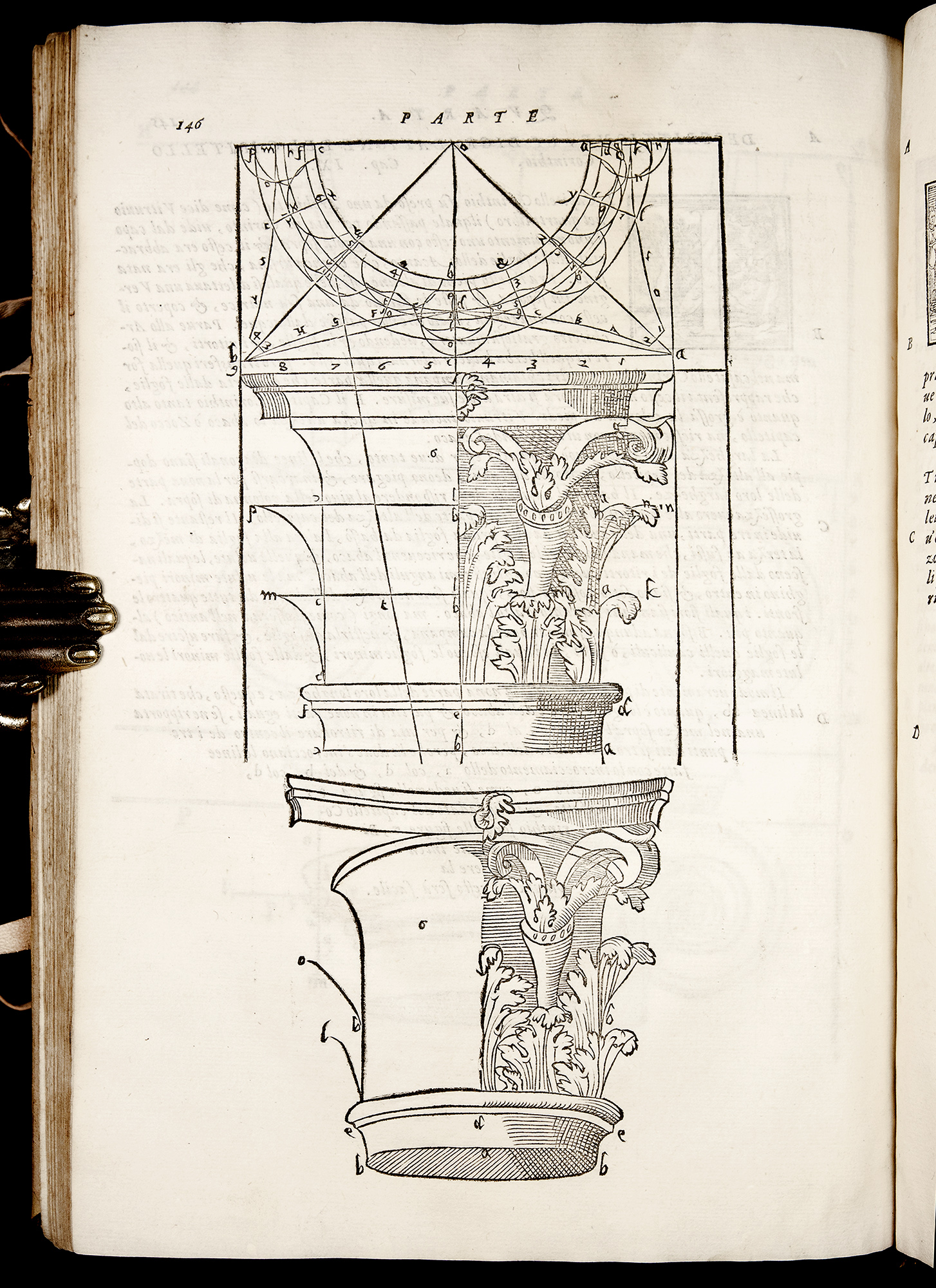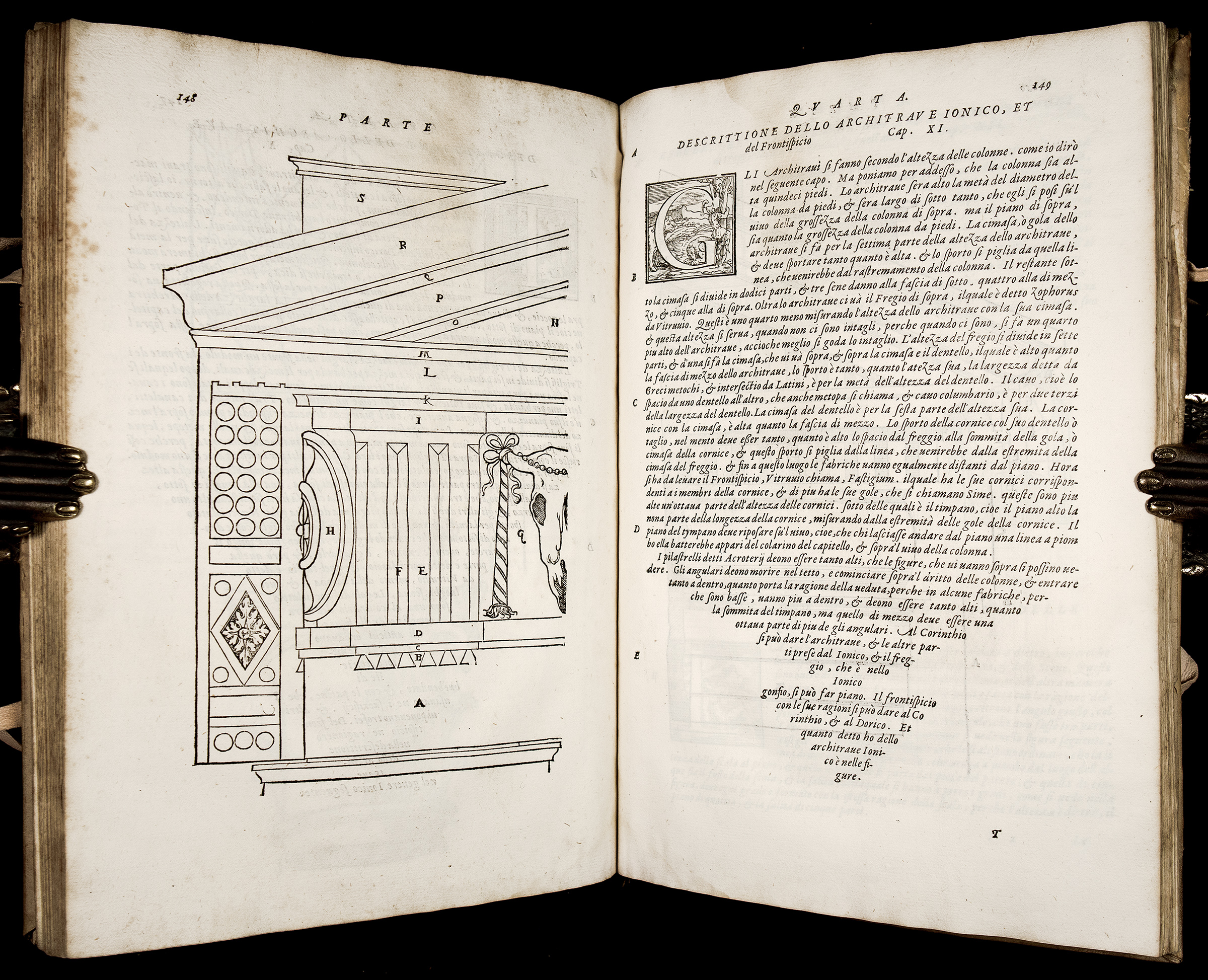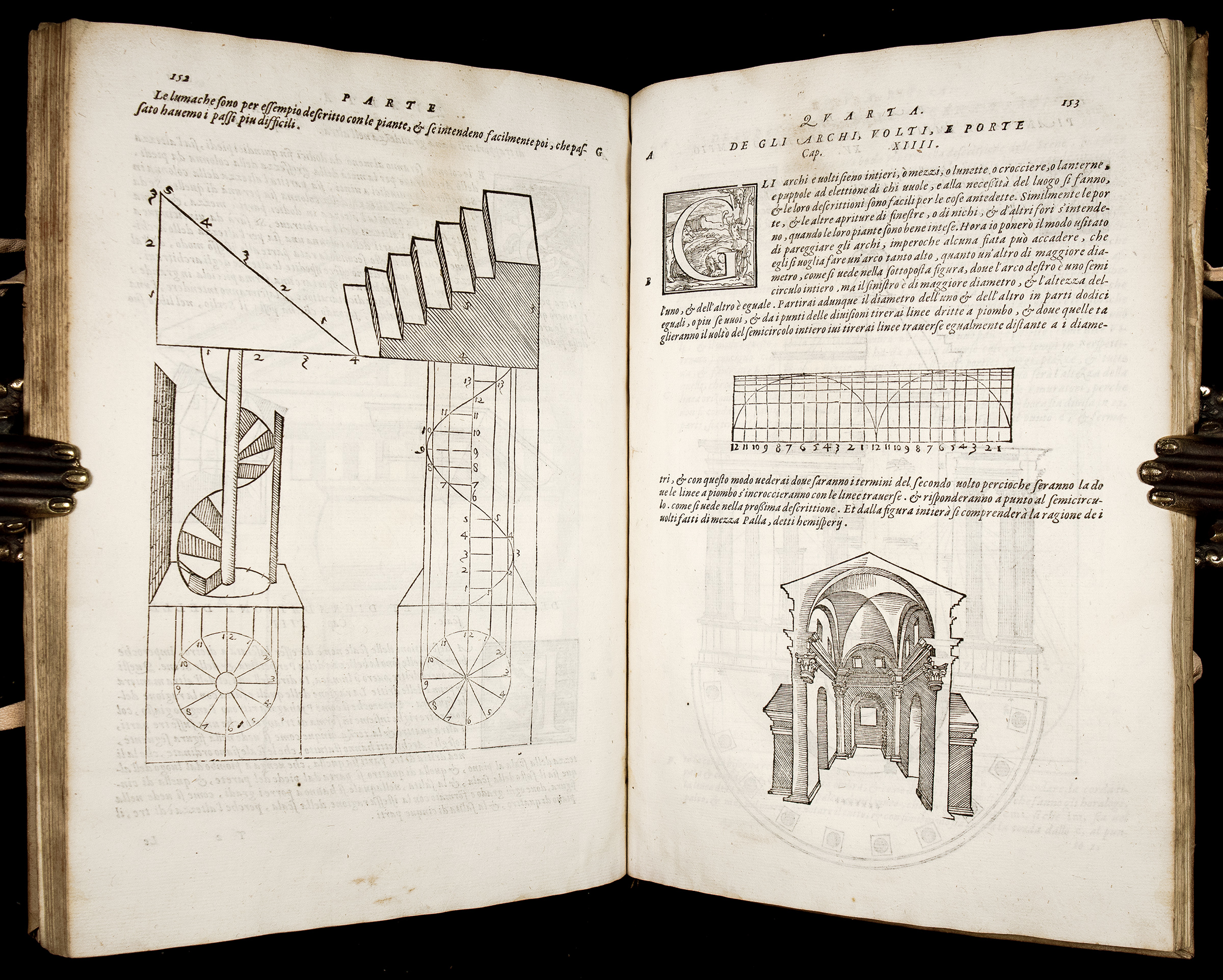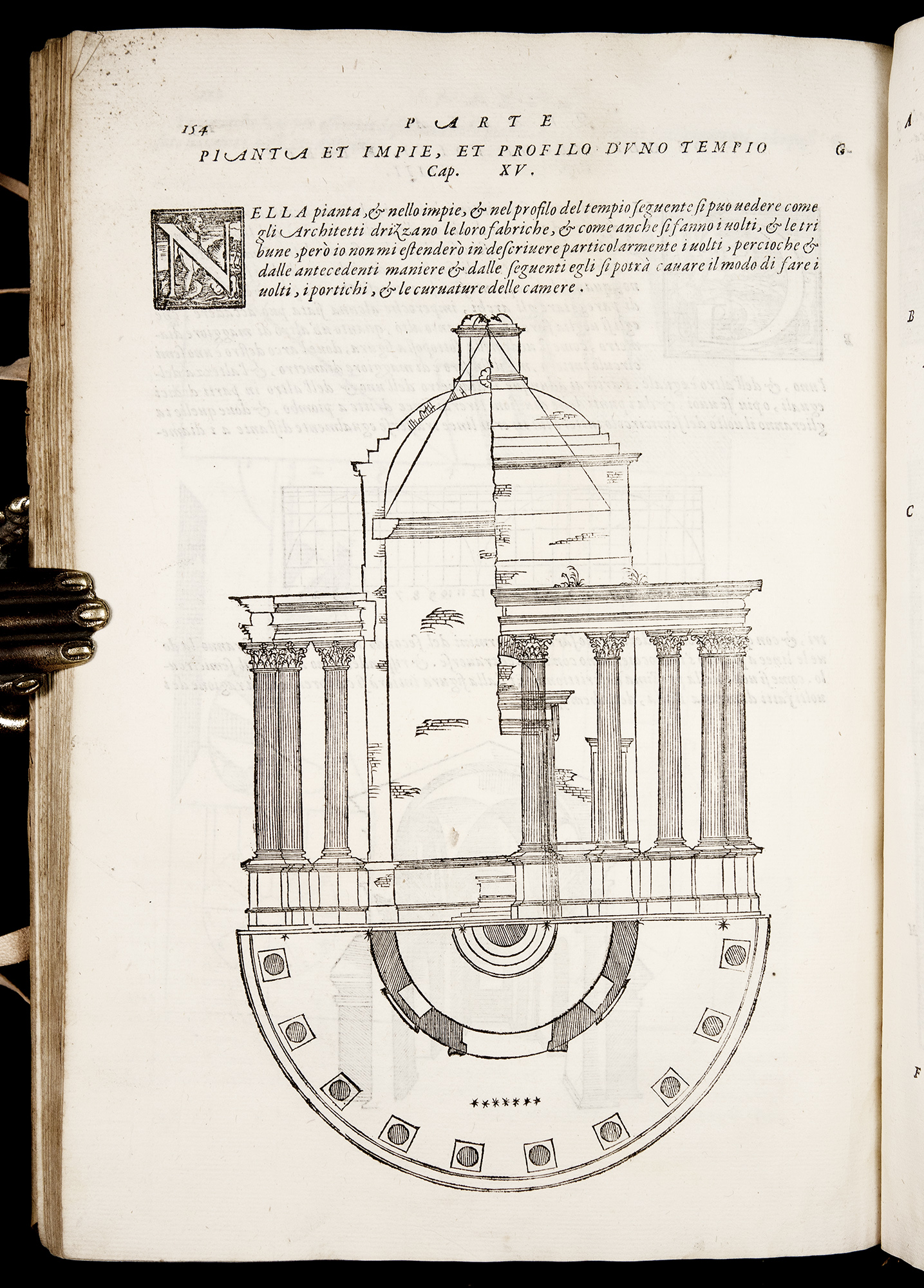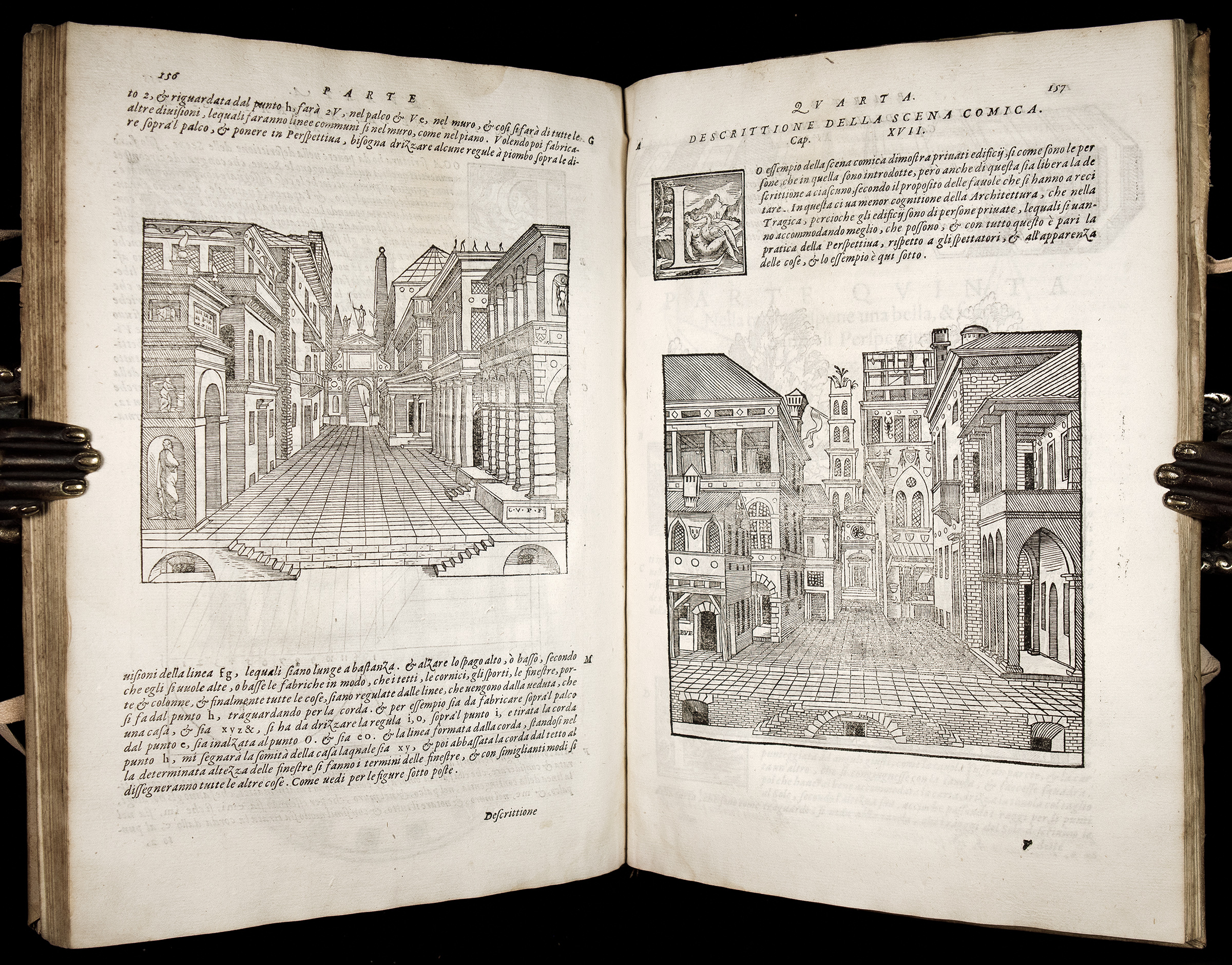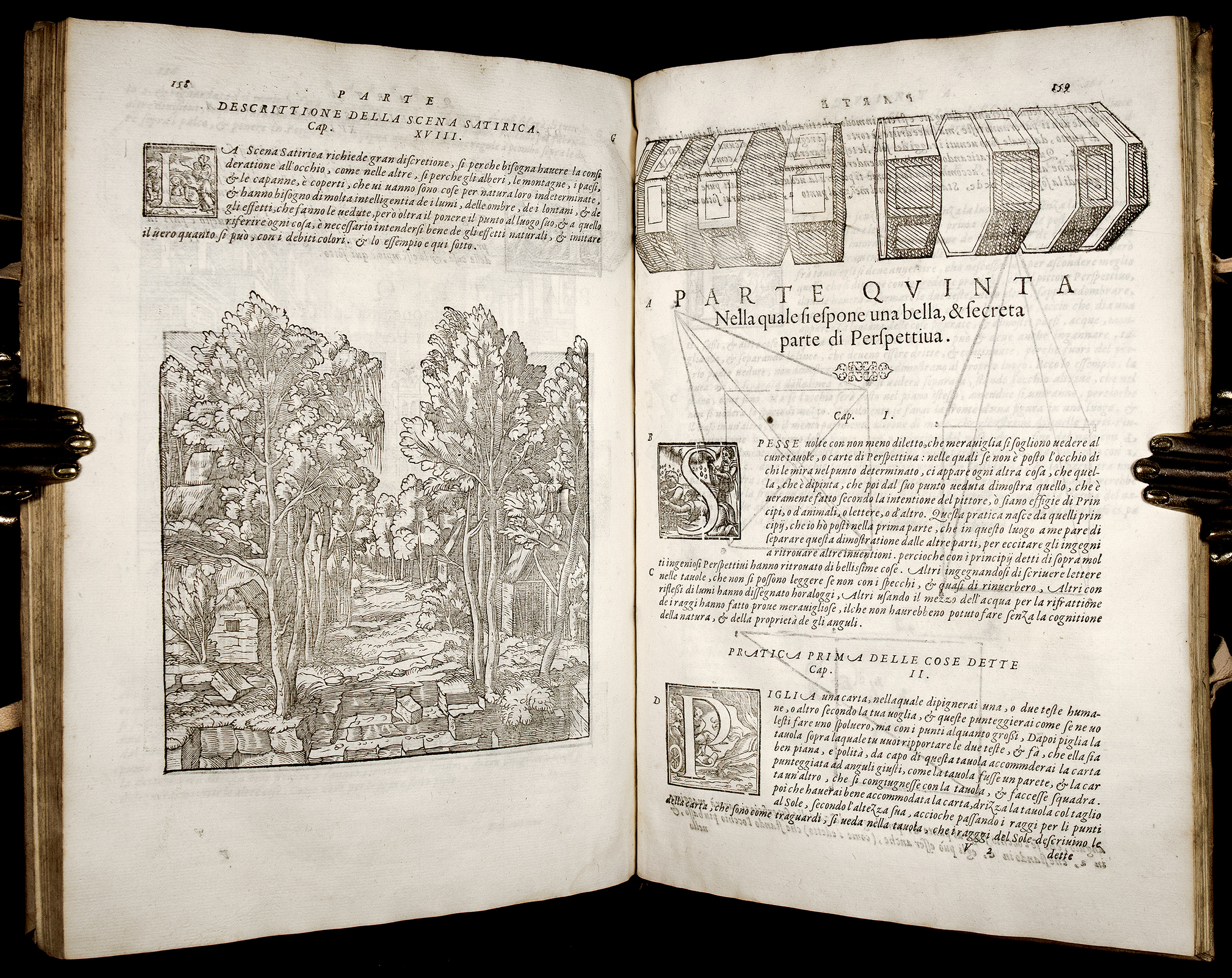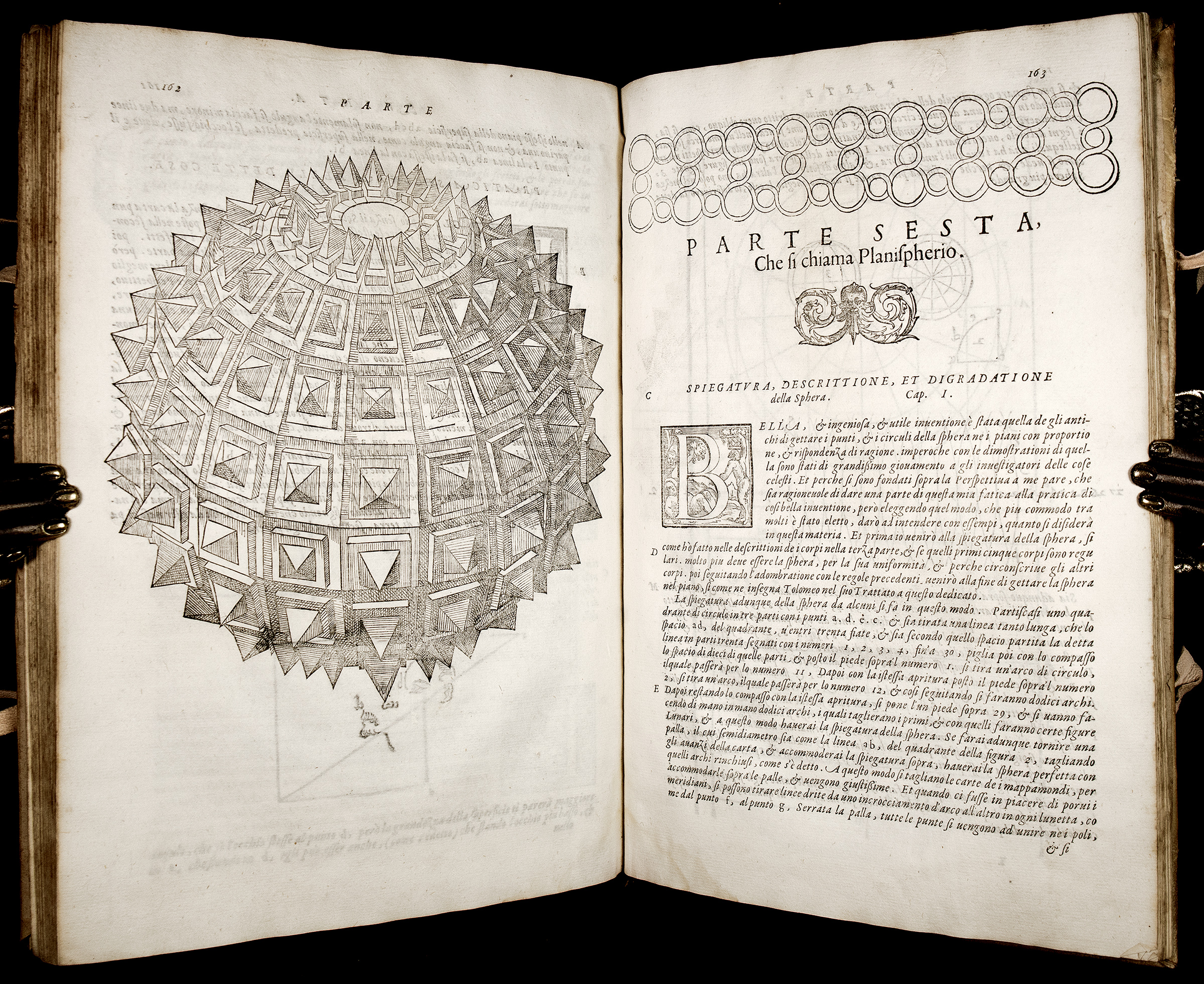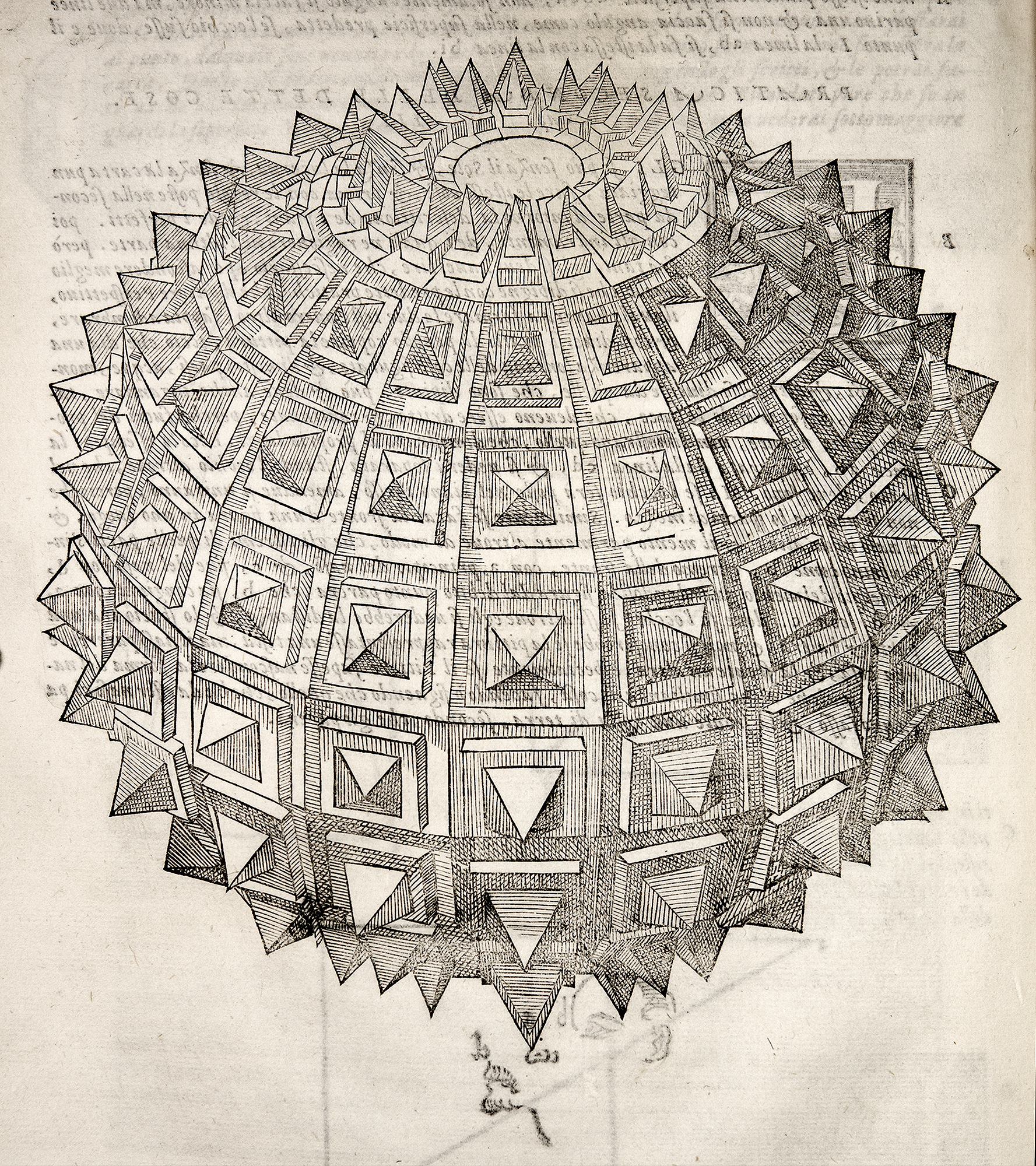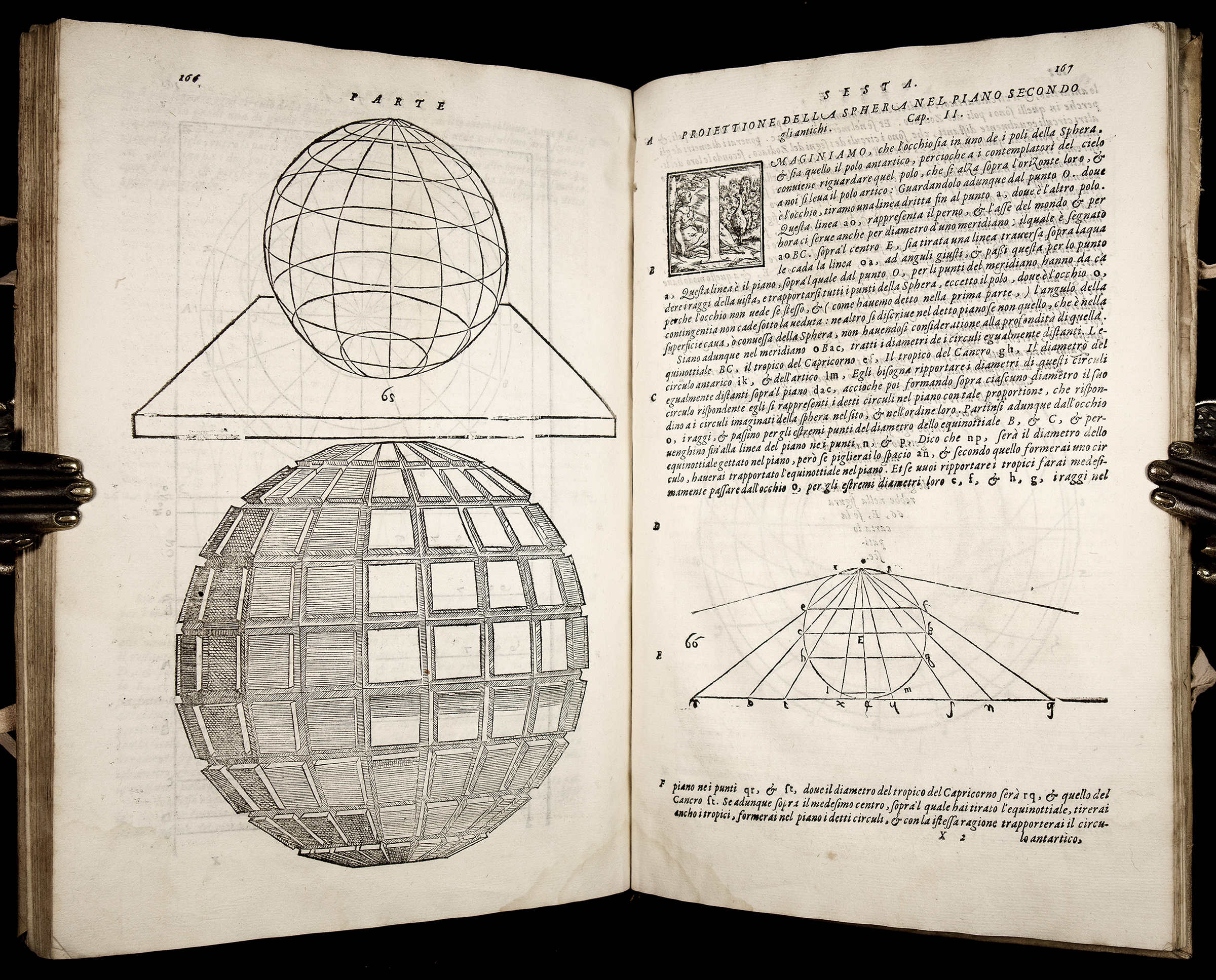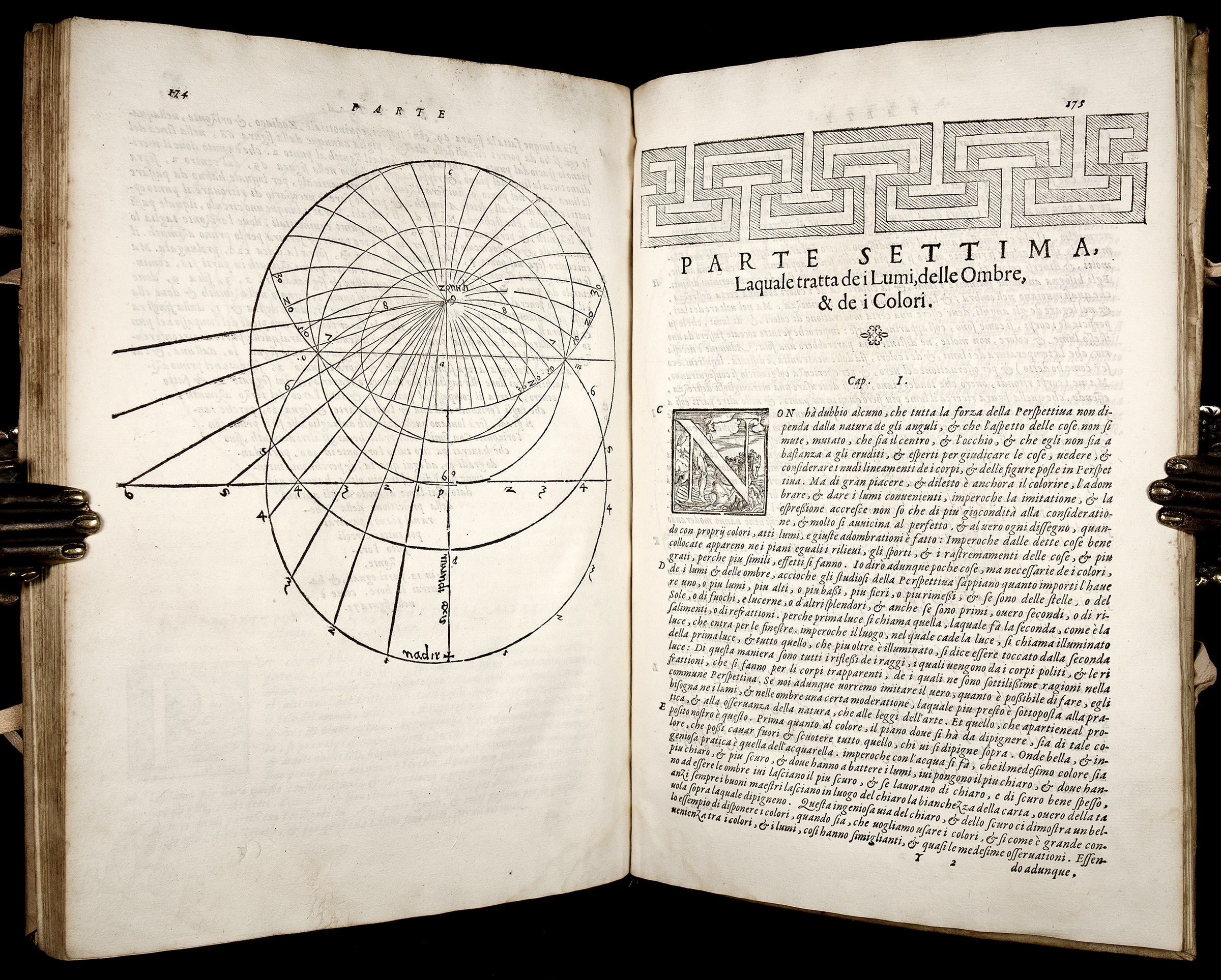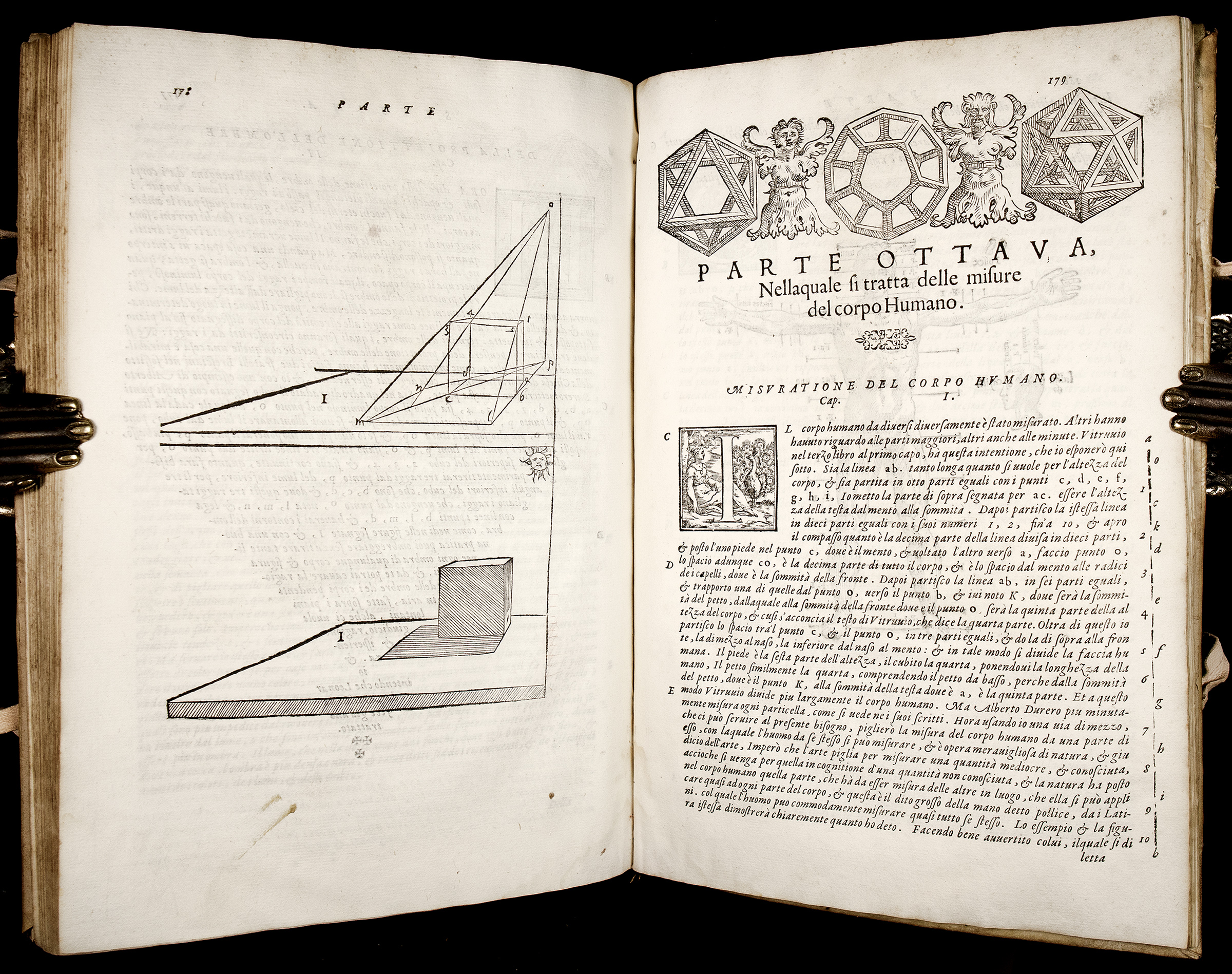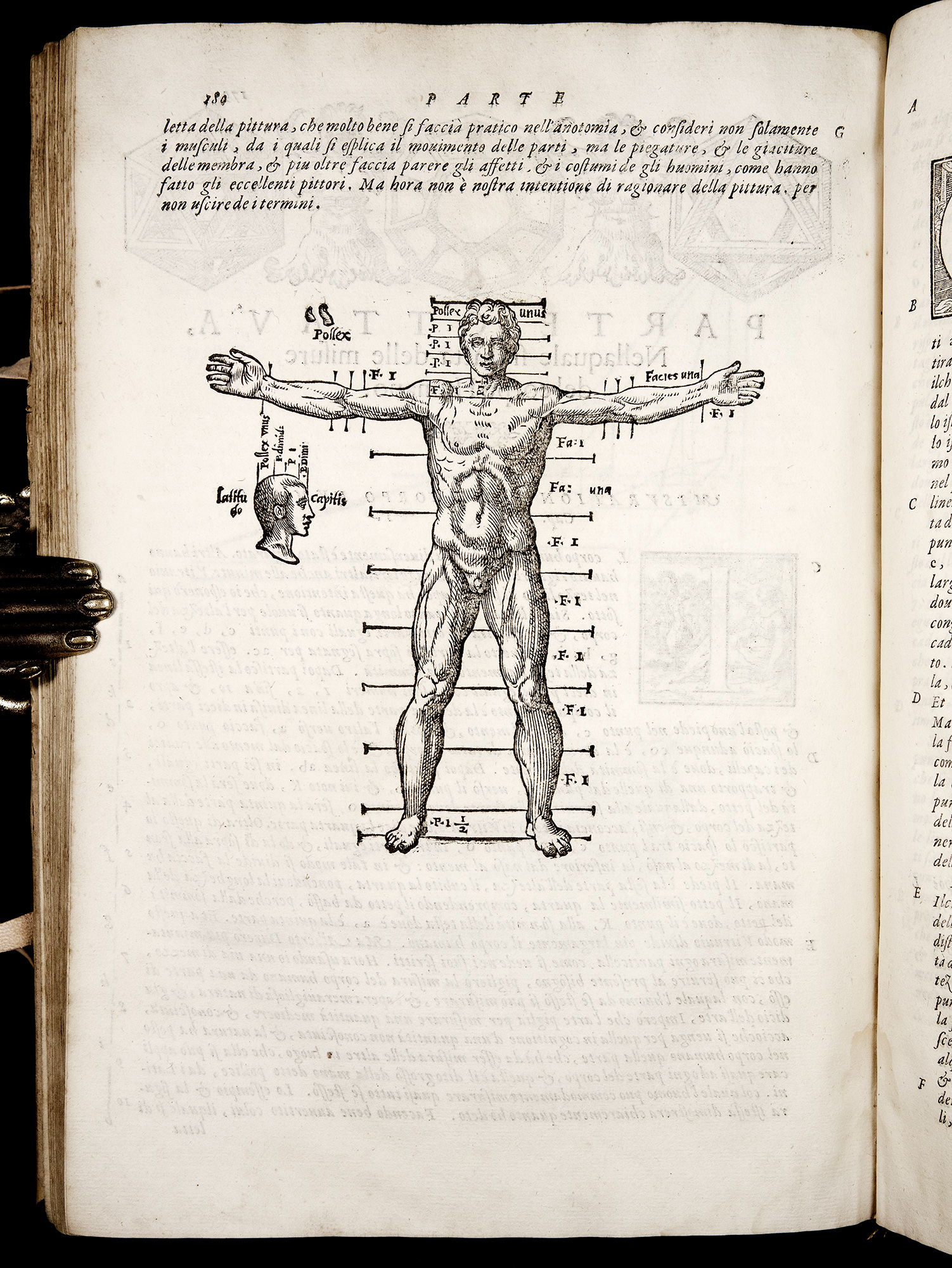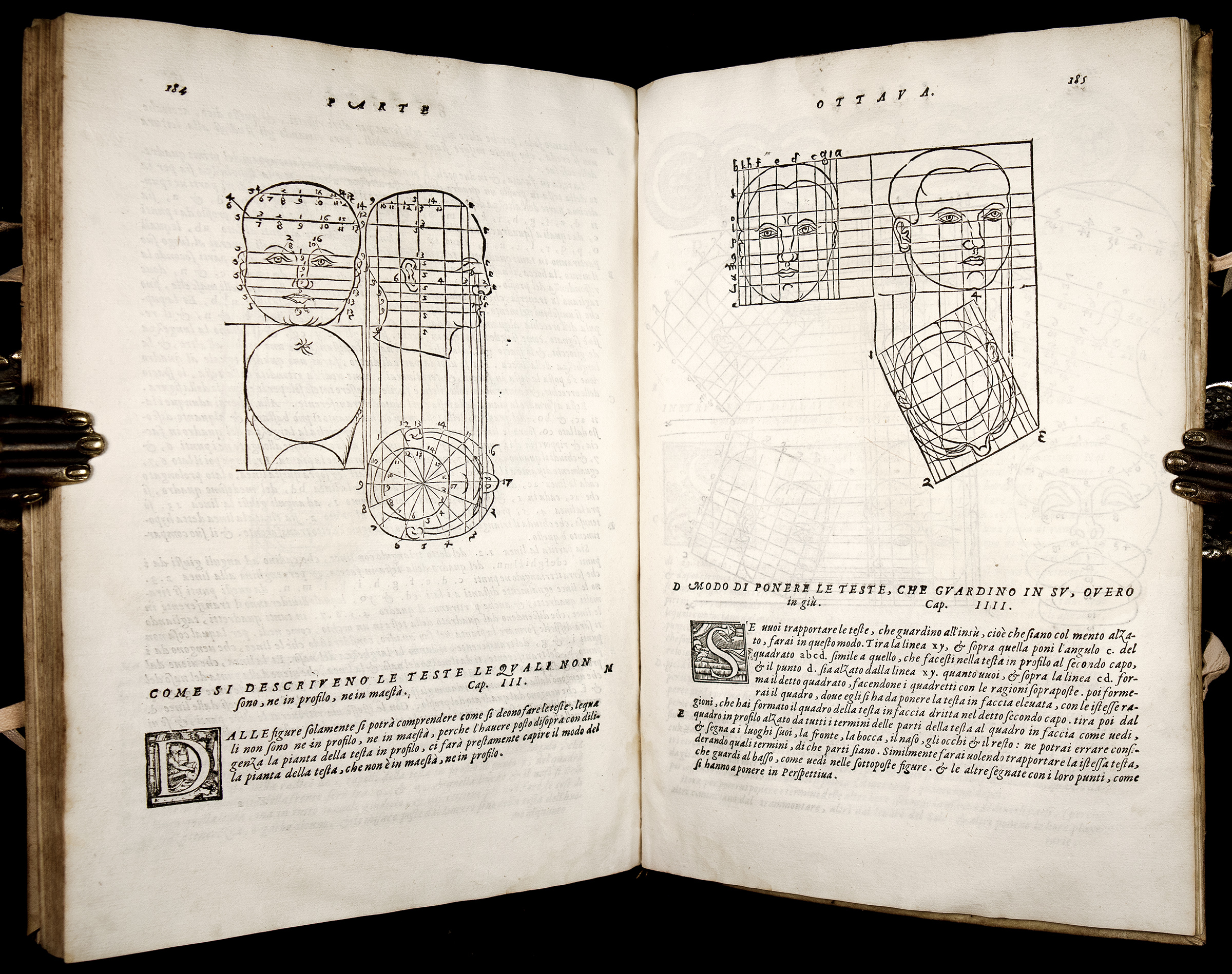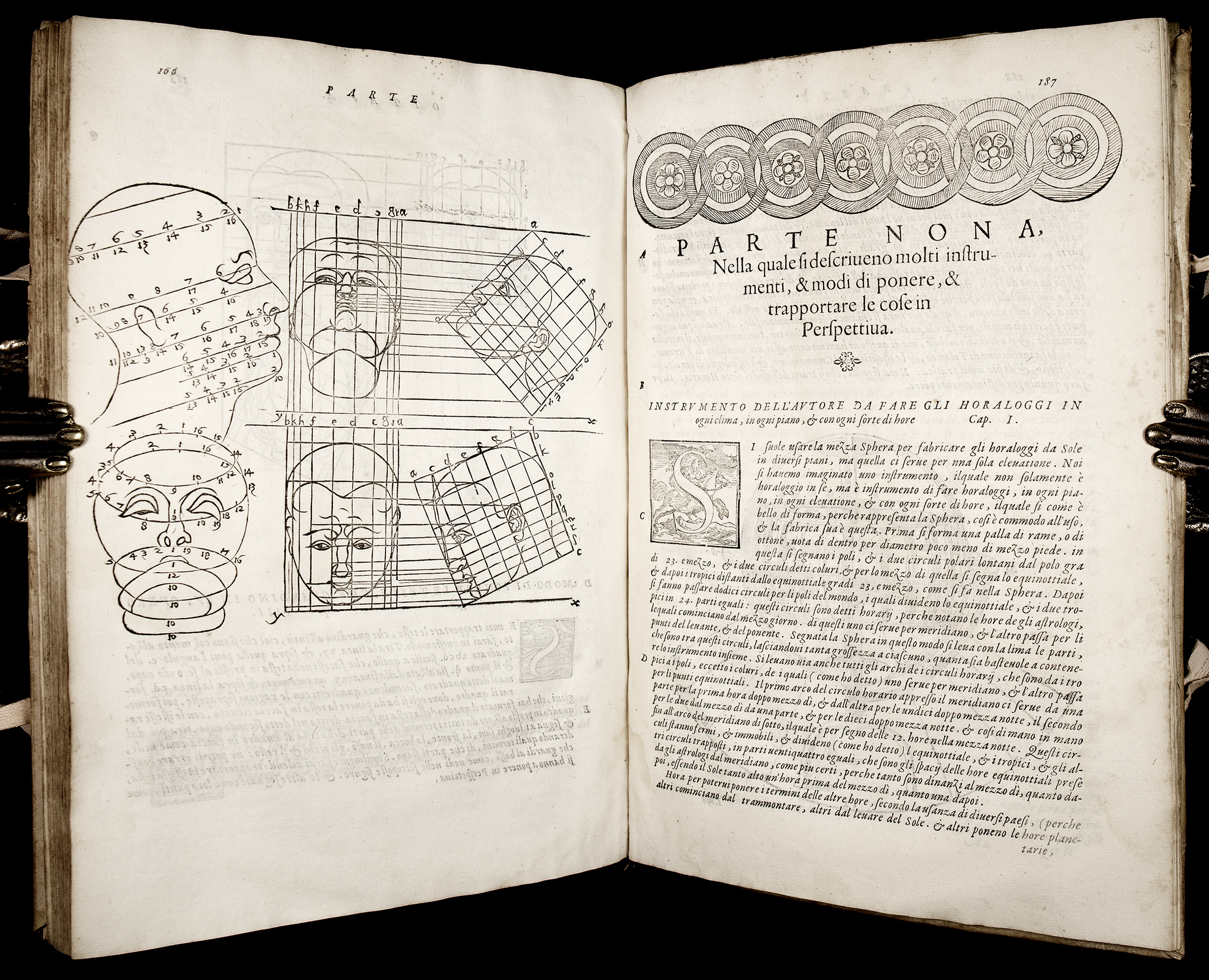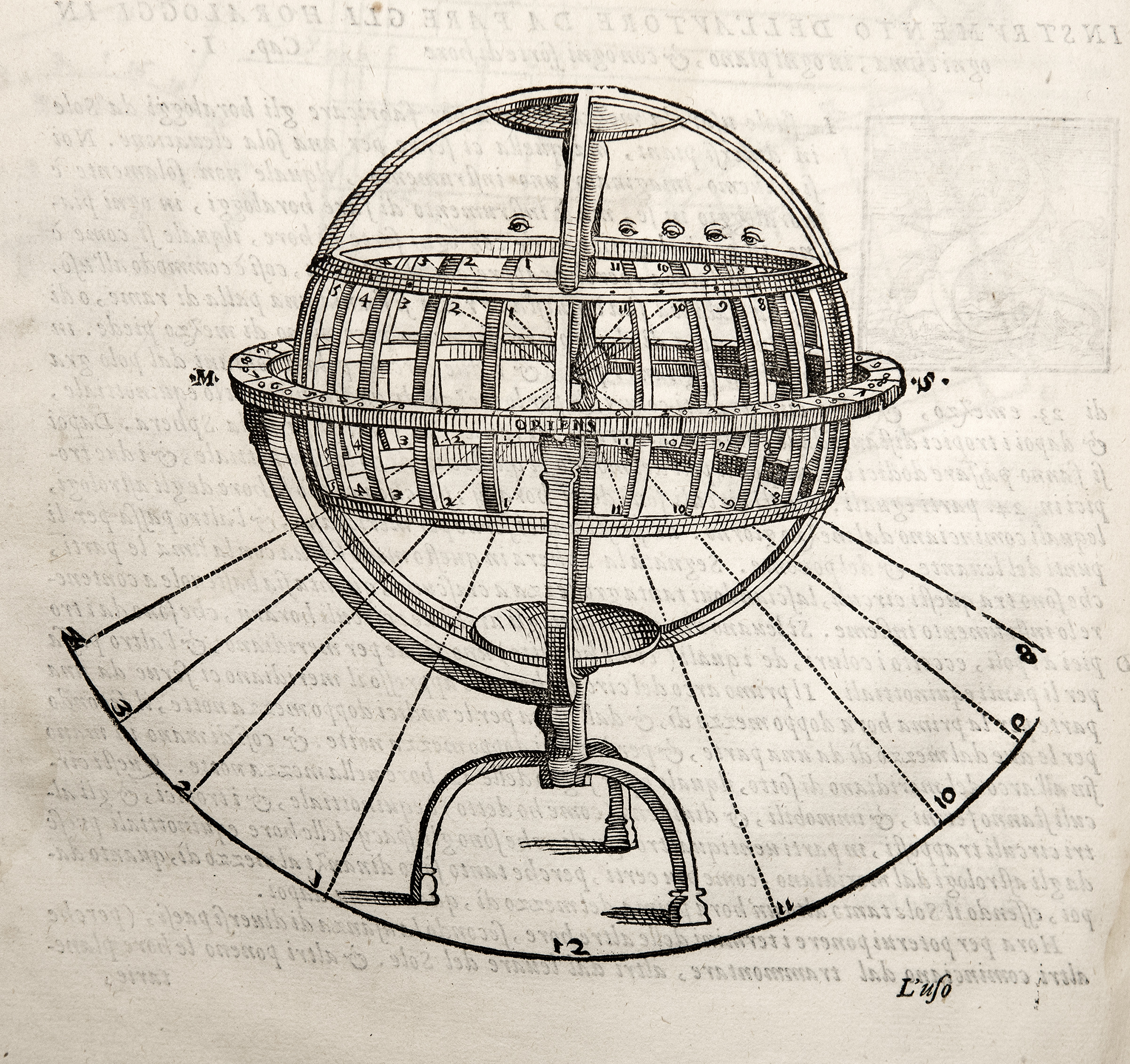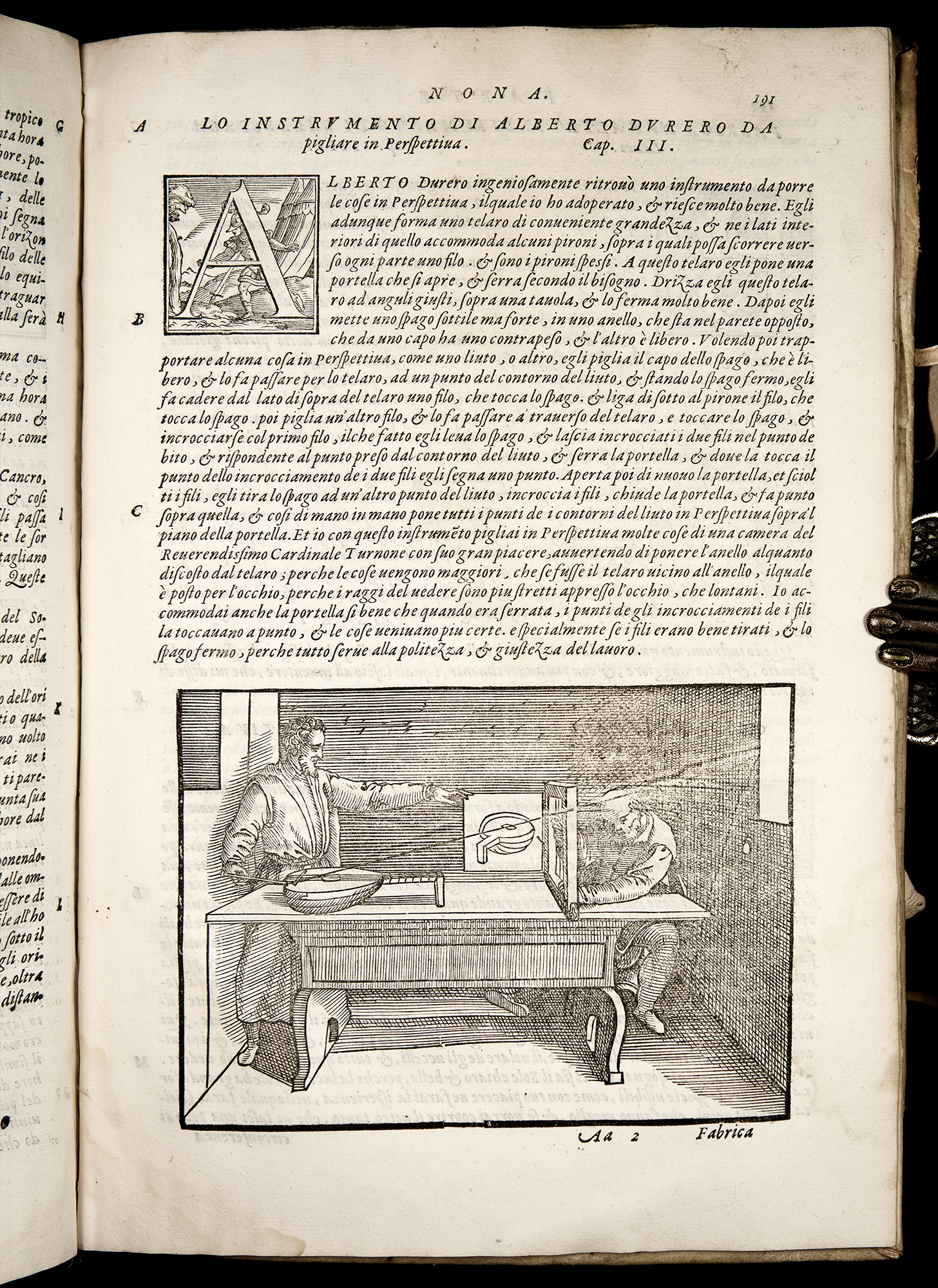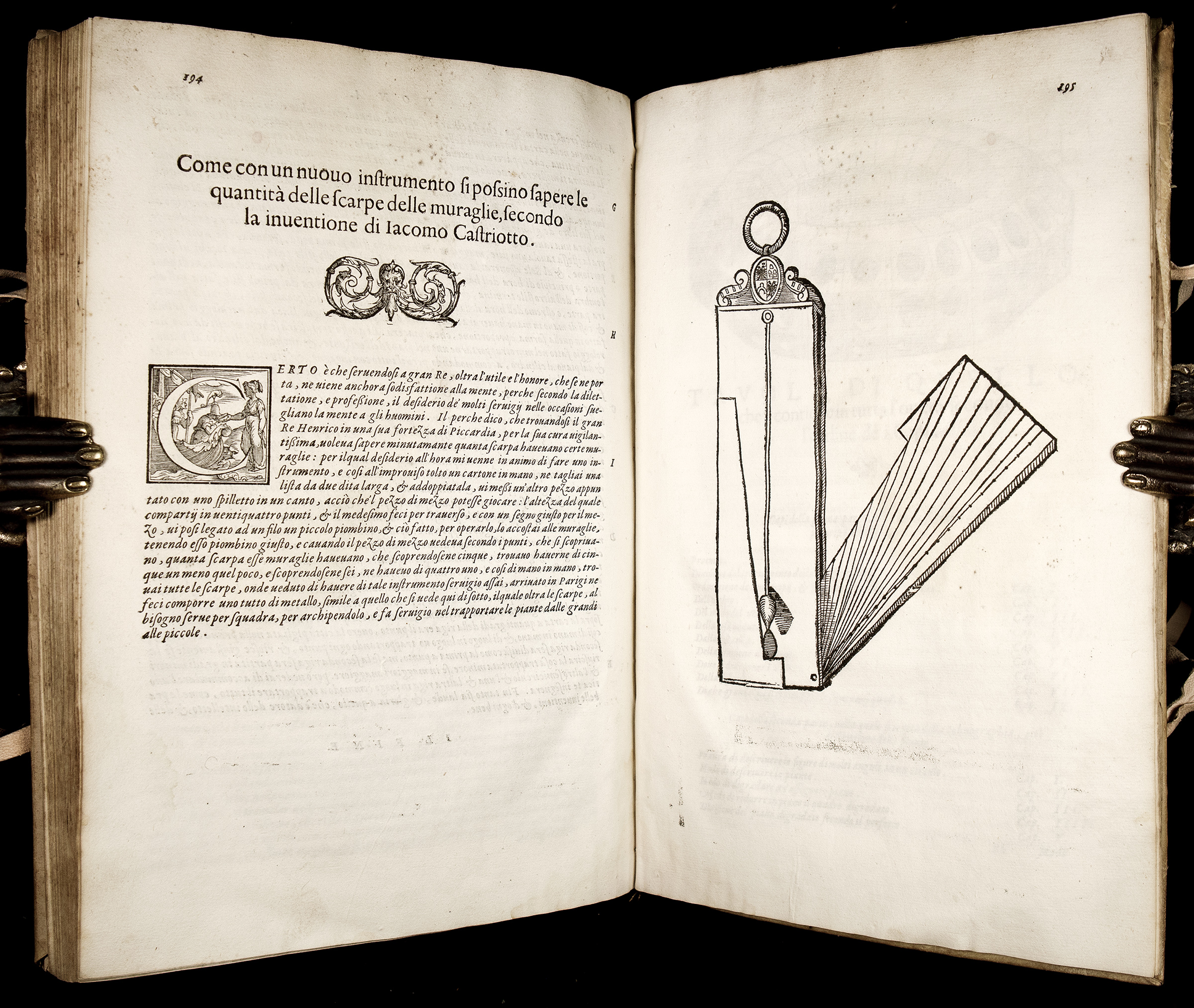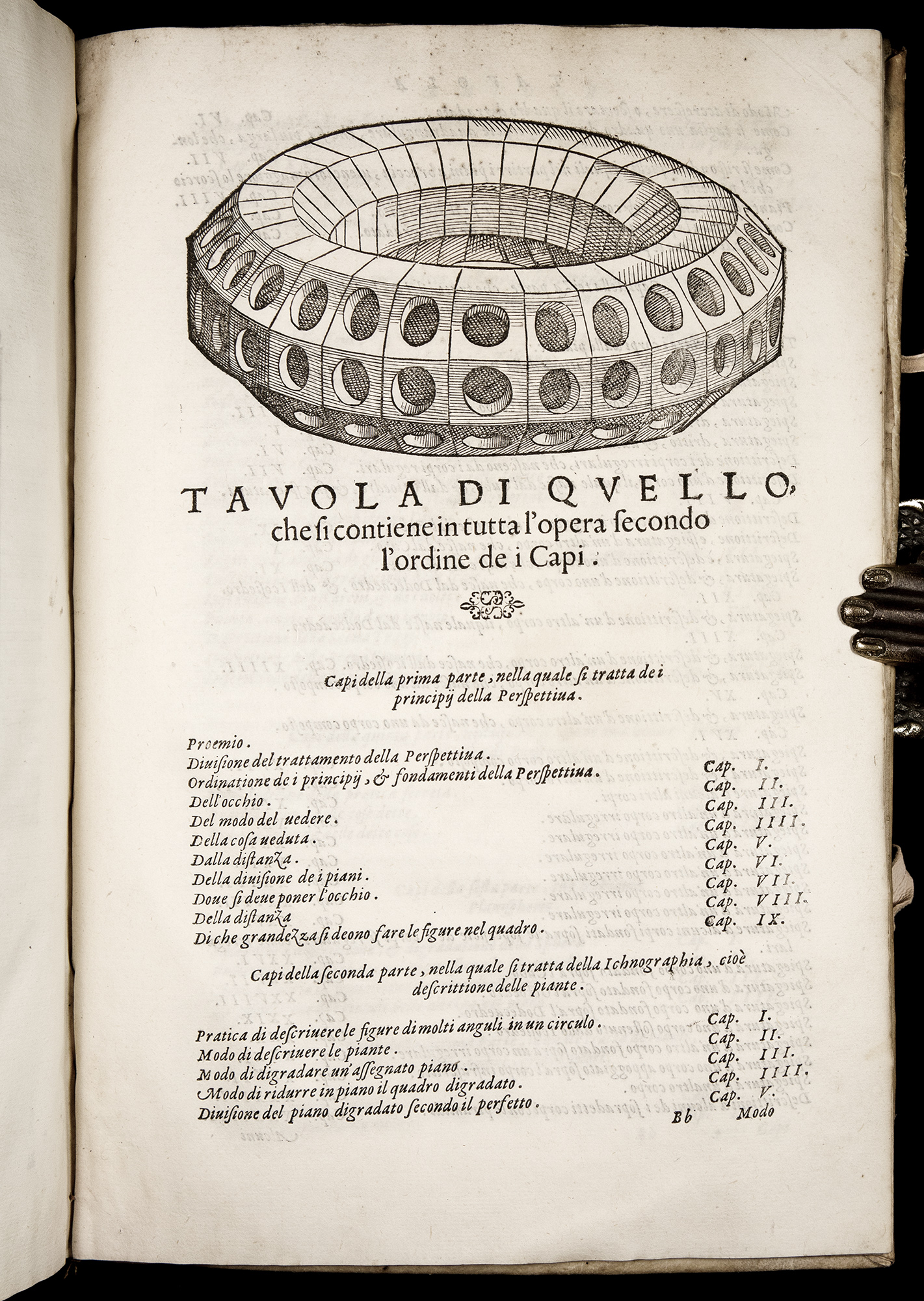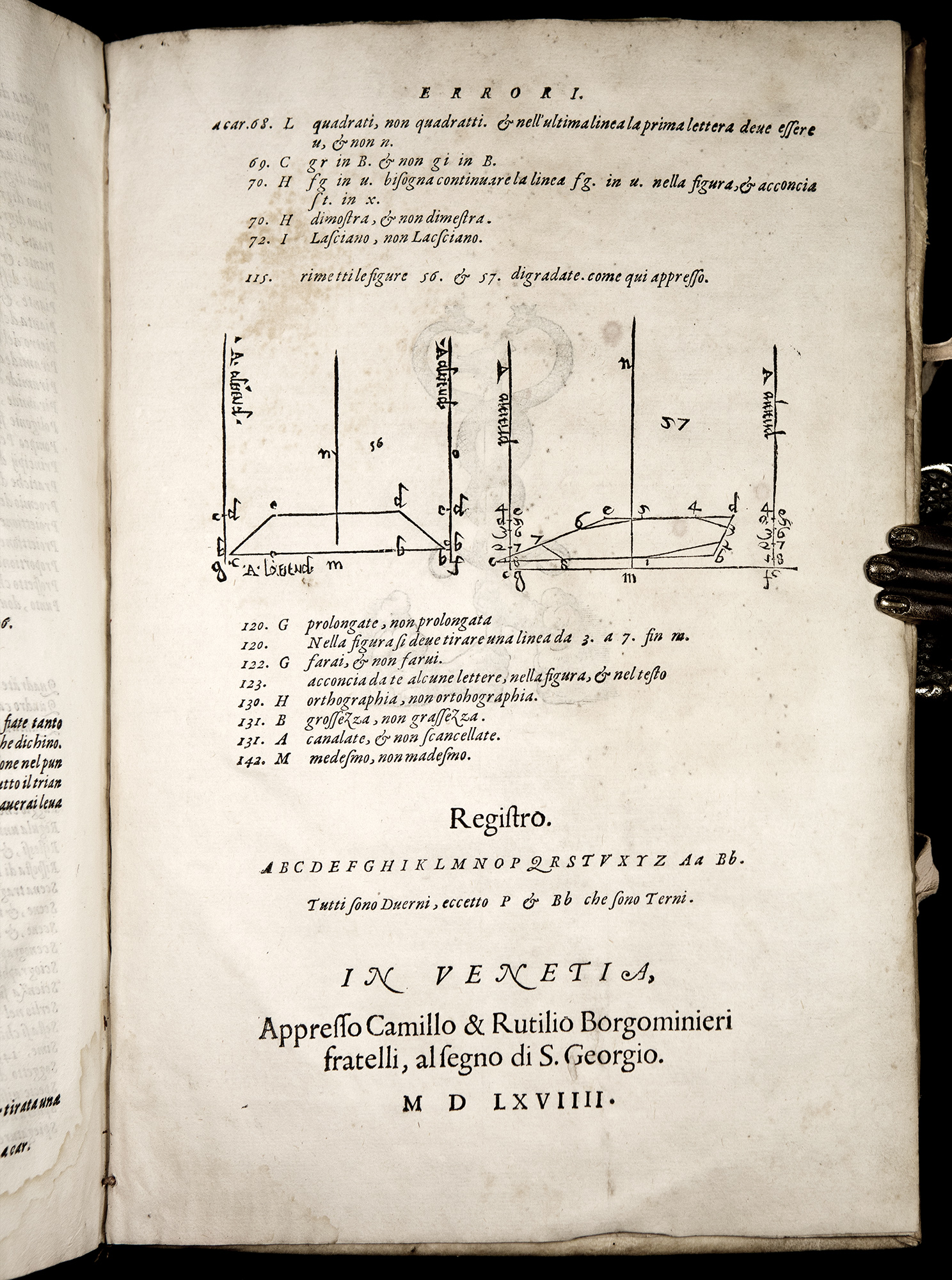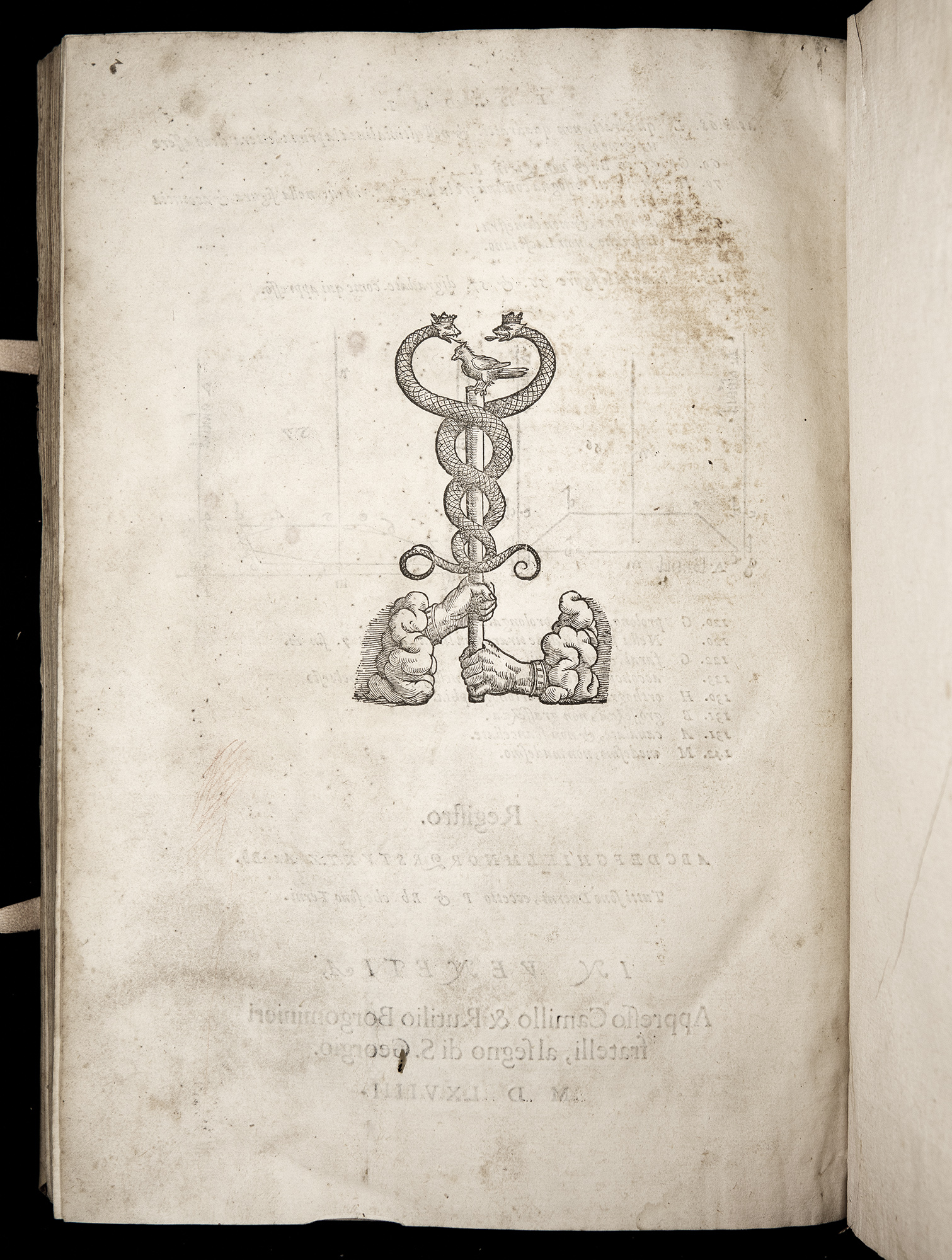
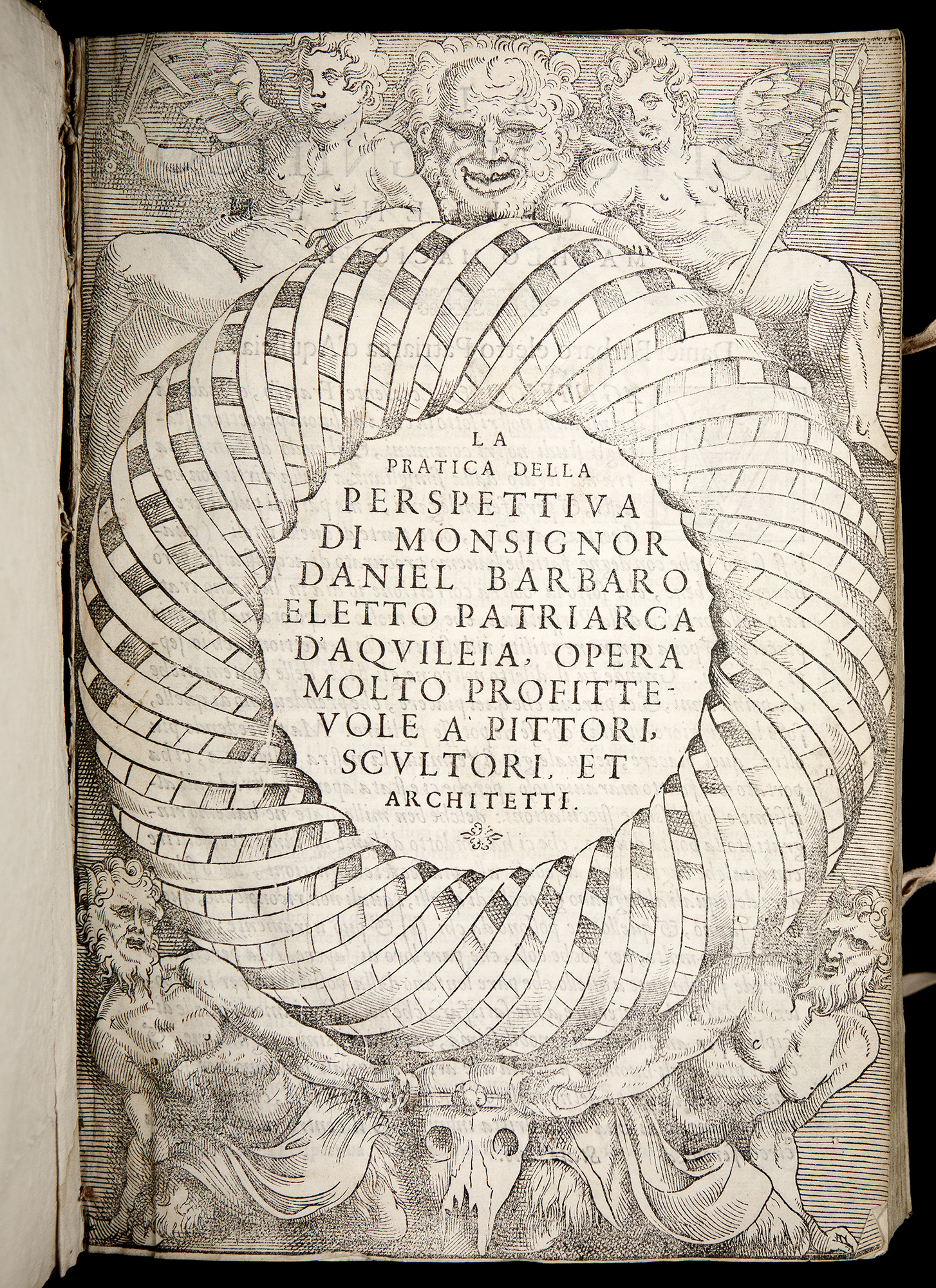
[Early Illustrated Books] [History of Science] [Geometry and Art - Perspective] [Polyhedra and Platonic Solids] [Architecture] [History of Photography - Camera Obscura] [Optics and Optical Illusions] [History of Theater - Scenography] [Proportions of Human Body] [Instruments for Drawing and Measuring]
DANIELE BARBARO
La Pratica della Perspettiva
Venice: Camillo & Rutilio Borgominieri, 1569.
SOLD
FIRST EDITION; second issue. Text in the original Italian. Profusely illusrated with over 200 woodcut illustrations and diagrams.
THE FIRST SYSTEMATIC TREATISE ON THE PRACTICAL APPLICATIONS OF PERSPECTIVE!
“OPERA DOTTISSIMA E DILIGENTISSIMA” (Cicognara).
This example has a rare and beautiful variant title-page with a spectacular woodcut border with a dramatic geometrical representation of a mazzocco (i.e. an interlaced ring), surrounded by satyrs and cherubs with drawing instruments. (The much more common state has a letterpress title with Borgominieri device).
The splendid woodcut title was clearly designed for this book, as were ten headpieces of similar geometric forms. Many of the woodcuts illustrating the text originate from Albrecht Dürer’s artist manuals, and the illustrations of stage sets are borrowed from Serlio.
The extremely influential treatise on perspective by Daniele Barbaro (1514-1570) was intended for practicing painters, sculptors and architects, was in part based on the work of previous theorists on perspective, particularly on Dürer's Unterweysung der Messung, and on the methods and writings of Piero della Francesca.
in this splendidly illustrated book Barbaro offers a theoretical exposition of projective geometry treating such topics as polyhedra, anamorphosis, and the camera obscura, as well as their application in such fields as architectural ornament, the Orders of Architecture, scenic modes and human proportion.
Barbaro’s important discussion of polyhedra is accompanied with accurate illustrations, and beautifully done perspective views of the polyhedra are also used as head pieces. In particular, the work includes the earliest drawing of the truncated icosidodecahedron.
Also of great intereest is the final chapter dealing with various instruments and containing the THE FIRST DESCRIPTION OF THE CAMERA OBSCURA FITTED WITH A LENS FOR ARTISTIC USE. The use of a lens in the camera obscura described in the book brought the device one step closer to the modern-day camera. The improvement in the image obtained with the device brought about by the inclusion of a lens as well as by adjusting the distance upon which the image is to be projected was described by Barbaro: "Close all shutters and doors until no light enters the camera except through the lens, and opposite hold a piece of paper, which you move forward and backward until the scene appears in the sharpest detail. There on the paper you will see the whole view as it really is, with its distances, its colours and shadows and motion, the clouds, the water twinkling, the birds flying. By holding the paper steady you can trace the whole perspective with a pen, shade it and delicately colour it from nature." (see J. Waterhouse, Notes on the Early History of the Camera Obscura, The Photographic Journal, vol. 25, pp. 270-290).
"The treatise by the erudite patriarch-elect of Aquileia, Daniele Barbaro, the distinguished Venetian patron of Andrea Palladio, was prepared by him, as he writes in his preface, because Federico Commandino's book on the subject, published ten years earlier by Aldo Manuzio in Venice, was too scientific and abstruse to be useful to artists. The other texts available at the publication time of Barbaro's 'Pratica' were those by Jean Pelerin Viator in French and Latin, by Albrecht Dürer in German and Latin, and in Italian the treatise by Sebastiano Serlio and a chapter in Pietro Cataneo's treatise. Of these only Serlio's and Cataneo's more modest work could be directly useful to architects.
"Barbaro was already known in artistic snd literary circles for his critical Latin edition of Vitruvius' De architectura, with illustrations commissioned from Palladio among others. [...] Relying heavily on Serlio, Barbaro also used extensively the unpublished treatise of Piero della Francesca compiled ninety years earlier, which circulated among scholars in a few manuscript copies. [...] In addition, Barbaro appropriated and reproduced Serlio's plates for the design of stage sets.
"Barbaro's treatise ... is divided into three main parts. In the 1st part he examines the principles of perspective, their consequence and graphic representation. In Part 2, Barbaro offers a discussion of the five regular polyhedra, continuing the tradition begun by Luca Pacioli and Leonardo. Part 3 is a study of scenography, optical illusions, planispheres, shadows, lights and colors, the dimensions of the human body, and instruments for drawing perspective. Barbaro's most significant contribution is in this 3rd part, where he offers the first analytic and scientific description of the camera obscura". (Martha Pollak, in Millard Architectural Collection. Italian and Spanish Books, Fifteenth through Nineteenth Centuries).
Daniele Barbaro (1514 - 1570) was one of the greatest Italian intellectuals of his time and a prominent patron of artists and scholars, such as Palladio and Titian. An eminent humanist with encyclopaedic interests, he published several books and left unpublished writings on a formidable range of subjects including philosophy, mathematics, astronomy, optics, history, music, and architecture. The corpus of his writings reflects the multifaceted nature of his personality and the broad spectrum of his activities. Born in Venice, Barbaro studied philosophy, mathematics, and optics at the University of Padua. He served the Republic of Venice as ambassador to the court of Elizabeth I in London and as representative at the Council of Trent: He was also Patriarch of Aquileia, an ecclesiastical appointment which required the approval of the Venetian Senate. He was also appointed to design and organize a research-oriented botanical garden for the University of Padua. On the death of his father, Daniele with his brother Marcantonio Barbaro inherited a country estate. They commissioned Palladio to design their shared country home Villa Barbaro. The villa was decorated with frescoes by Paolo Veronese, who also painted oil portraits of Daniele.
Physical description:
Folio. Textblock measures 288 mm x 195 mm. Contemporary (late 16th-century) semi-rigid vellum; two pairs of leather ties (renewed).
Pagination: 195, [1]; [12] pp.
Signature collation: A-O4 P6 Q-Z4 Aa4 Bb6.
COMPLETE!
Printed in Italic letter.
Title-page within a magnificent woodcut border with a wreath of interlaced spirals supported by Satyrs. Several fine large woodcut polihedron head-pieces. Historiated and foliated woodcut initials. Over 200 woodcut illustrations and diagrams in text [220 woodcuts by RIBA count], of which many are full-page, and one double-page.
Ruth Mortimer gives the following description of the illustrations in this extraordinary book:
"These [illustrations] include twenty-two full pages [and], one double-page (leaves P3v-P4r), and one plate at the end. The final plate is an illustration of a new measuring instrument by Giacomo Fusto Castriotto, on the recto of leaf Aa4, verso blank. On leaves T4v-V1v are three blocks of theatre scenes from Francesco de Franceschi's 1566 edition of Serlio, dedicated to Barbaro. The woodcut on leaf Aa2r, shoing two men using a drawing instrument to copy a lute, is a free copy of Albrecht Durer's woodcut […] which appears at the end of his Underweysung von Messung, Nuremberg, 1525. Other Durer illustrations from the Messung and Von menschlicher Proportion were adapted by Barbaro for this volume. [...] Ten large head-pieces were designed for this volume: one for each of the nine parts and the index."
Leaves P3 and P4 (comprising the double-page centerfold illustration) have folded flaps at fore-edge (since these leaves extend beyond the rest of the textblock).
Includes (on verso of title) Barbaro’s dedication to Matteo Macigni (an Italian philosopher and mathematician, professor at Padua and a member of the Accademia degli Infiammati who was part of the entourage of Pietro Bembo and Daniele Barbaro).
Included at the end of the volume are: a table of contents (Bb1r-2v); index (Bb3r-5v); errata (Bb5v-6r). Register and colophon on Bb6r, with a woodcut printer’s device of Borgominieri brothers (serpent-wreathed staff) on verso.
Condition:
Very Good antiquarian condition. Complete. Vellum binding with some soiling, and a a repaired area at top if the rear cover (patched up in contemporary vellum). Binding solid and secure; hinges intact. Original pastedowns and rear endpaper (front free endpaper removed). Internally with an occasional light soiling; light-to-moderate water-staining: generally quite harmless, with a tidemark showing on a few leaves. In all, a solid, genuine example of this scarce, beautifully illustrated work, with the particularly rare and desirable variant title-page.
Bibliographic references:
Adams B-171; Berlin Kat. 4694; Brunet I, 644; Cicognara 809; Fowler 36; Gamba 1233; Vagnetti E IIb23; Wiebenson III-B-7; Kemp, The Science of Art, 76-8; p. 189; Mortimer Italian 39; RIBA (1568 issue).
